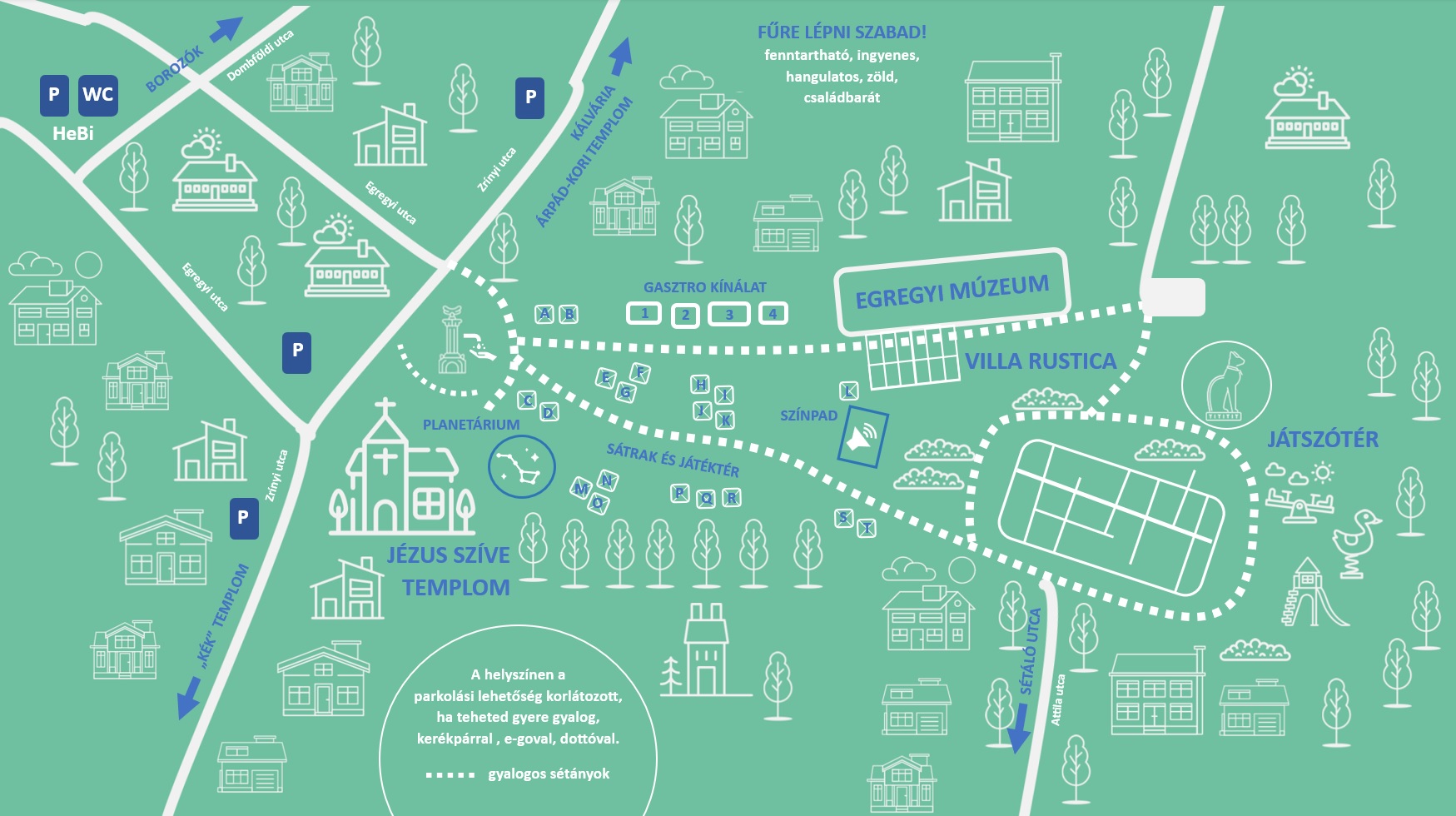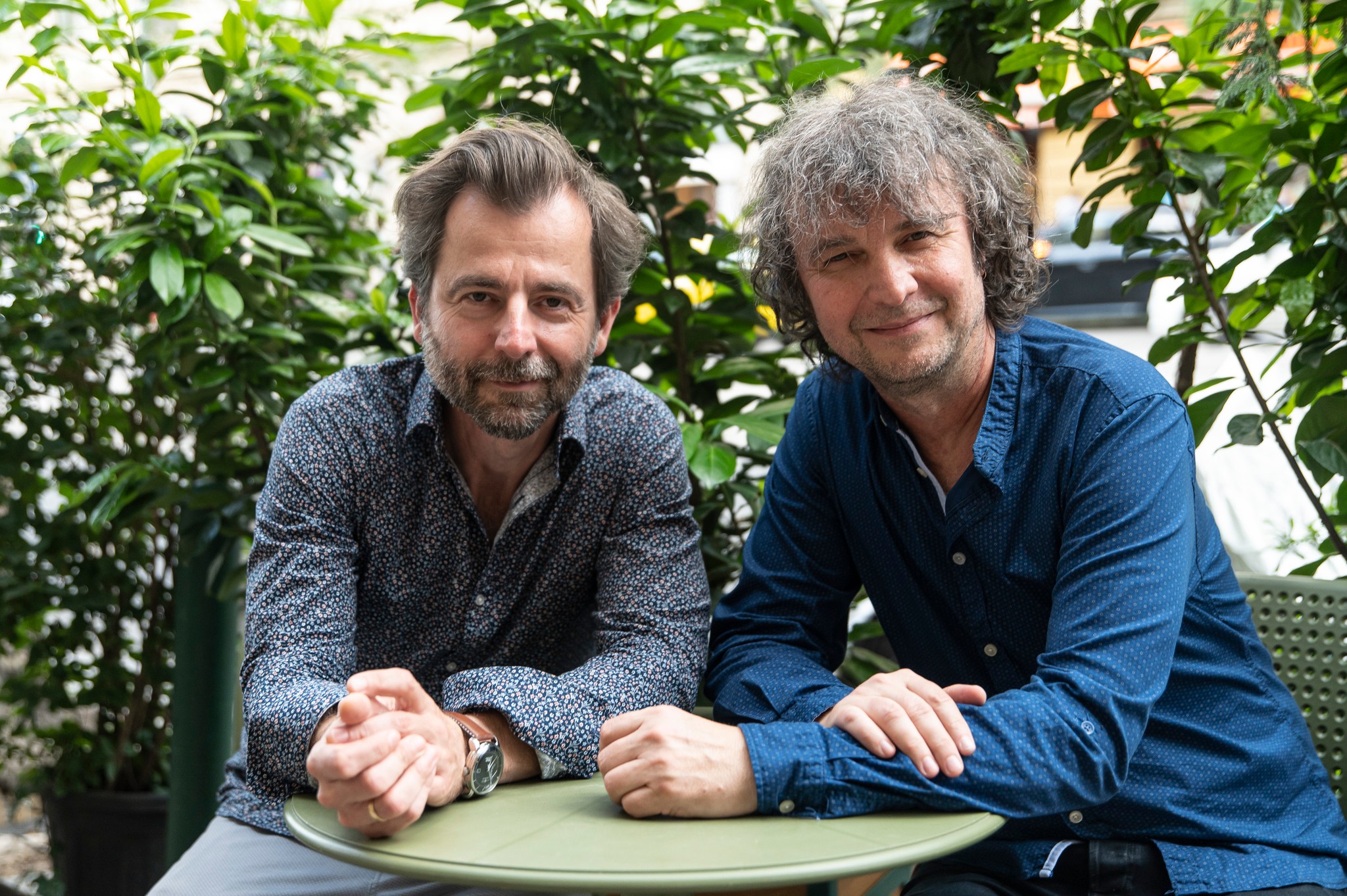Search
Kizárt szavak
Tiltott szavak
- cialis
- viagra
- php
- sql
- html
- https
- http
- chr
- script
- sex
- porn
- sexmassage
Alternatív kifejezések
- =
41. EKF - Hévíz
Last modification: 2025. March. 19. 12:25
Találati relevancia adatok
Tárolt adatok:

Find the music!
The "music" of the GROUND, the WIND, the WATER and the BIRDS - microconcers in secret spots of the Protective Forest.
Wander through the charming paths of the Forest and find the music of the forest. Enjoy the soft music and the cool of the trees. You can listen to short, 15-minute micro-concerts in the secret venues hidden in the trees, once in every hour.
23 June 15.30 in the West Protective forest, on the Treetop Walkway
14 July 16.00 in the Northern Protective forest
4 August 16.00 in the Northern Protective forest
18 August 16.00 in the Northern Protective forest
8 September 16.00 in the West Protective forest, on the Treetop Walkway
15 September 16.00 in the Northern Protective forest
We reserve the right to change the program! In case of rain, the program will be held at a new time or at a different location depending on the occasion!
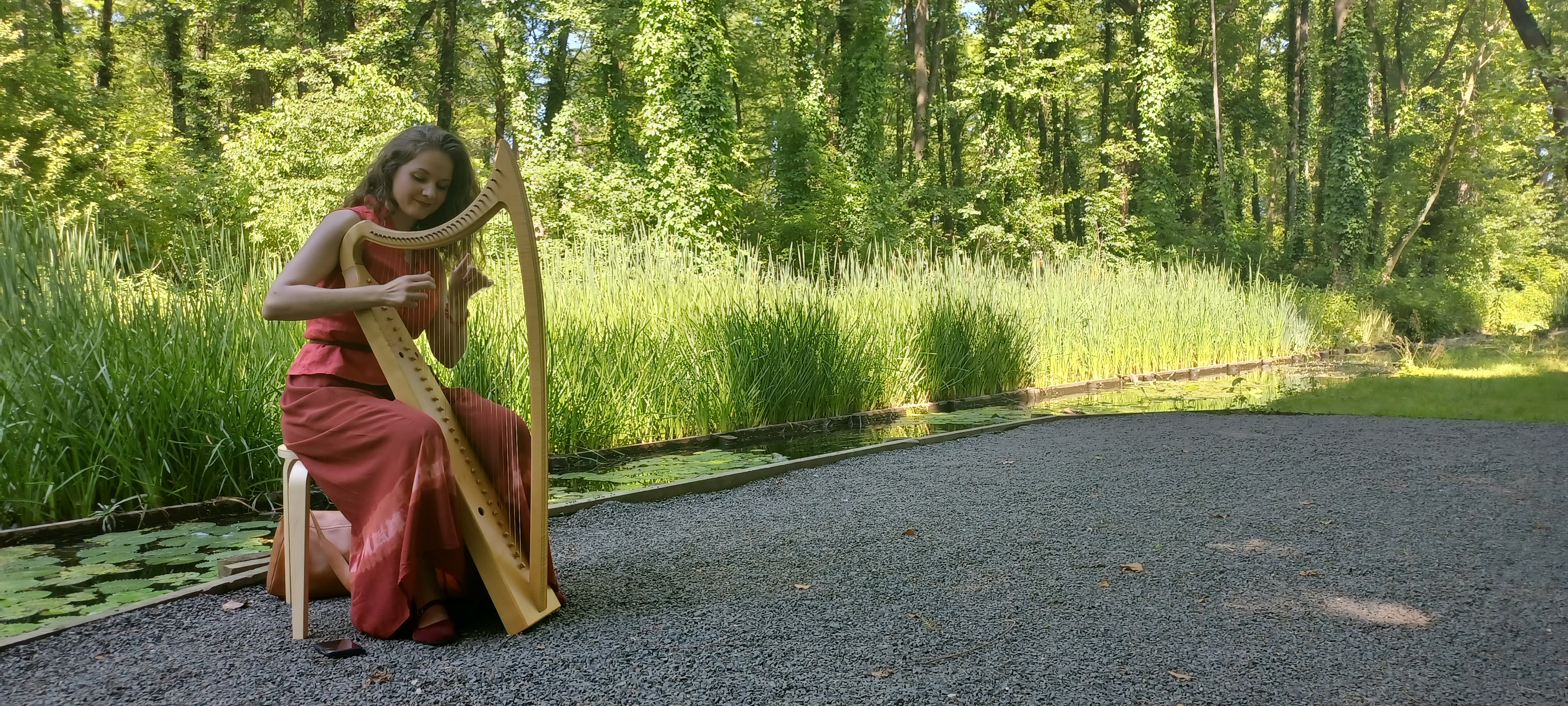

Egregyi Museum Garden - August 4-6. Friday-Saturday-Sunday
First Egregy Eco-festival
Step on the grass allowed! Try it, experience it, learn it, listen it, enjoy it, see it…performances, arts and craft show, creative works and many others!
programs before the festival
3 August, Thursday
20:00 Trio Brax concert
21:00 Bossa & More Concert
4 AUGUST, FRIDAY
16:00 pART forest exhibition opening and micro-concerts in the Northern Protective Forest
Between 16:00 and 18:00 Gastronomic presentation - Tanácsa Attila's cooking school (vegan, vegan dishes)
16:00 - 20:00 Try it, experience it, learn it, listen it, enjoy it, see it... in the tents set up in the museum garden in Egregy: singing bowl session, mandala painting, lifestyle advice, right hemisphere drawing, vegan food, gastro show, craft creative sessions and much more!
16:00 Brum Bandi Band
17:50 Film: Climeate-film - film of the Balaton-Uplands National Park
18:30 Klára Hajdu and Milán Szakonyi concert
20:00 Ivett & JB Jazz concert
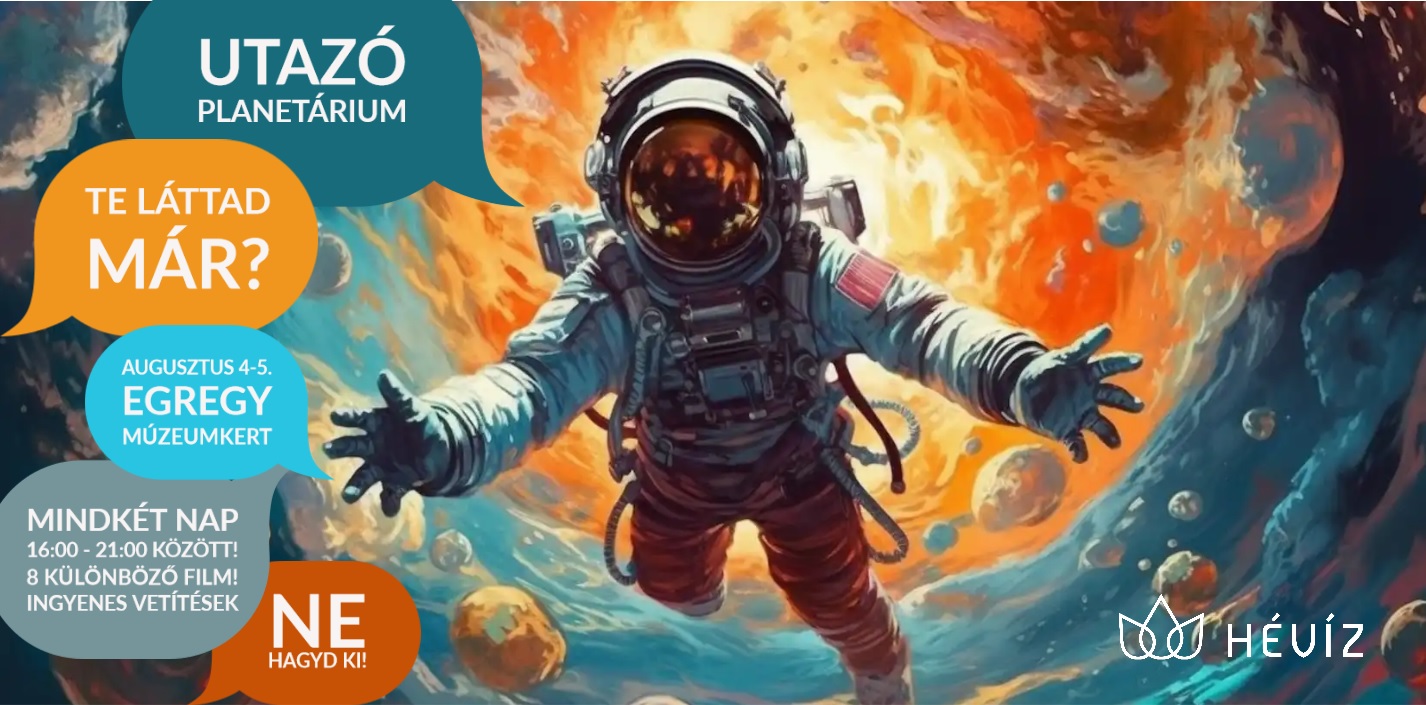
5 August, Saturday
10:00 Morning Yoga
10:00-18:00 Try it out, experience it, learn it, listen to it, enjoy it, see it... in the tents set up in the museum garden in Egregy: sound bowl session, mandala painting, lifestyle advice, drawing with the right hemisphere, vegan food, gastro show, craft creative sessions and much more!
10:00 - 18:00 Playhouse
11:00 Gastronomy presentation with tasting - Attila Tanácsa cooking school (vegan, vegan dishes)
14:30 - Joy dance for and with seniors
15:00 Gastronomy presentation with tasting - Attila Tanácsa cooking school (vegan, vegan dishes)
15:00 Nature film: Wild Waters
16:00 Igricek concert
16:00 Caricature painting with Tibor Karnics
From 4:00 p.m. TRAVELING PLANETARIUM - new shows every hour in a traveling planetarium
Amazing universe film (from 6 years old) in English
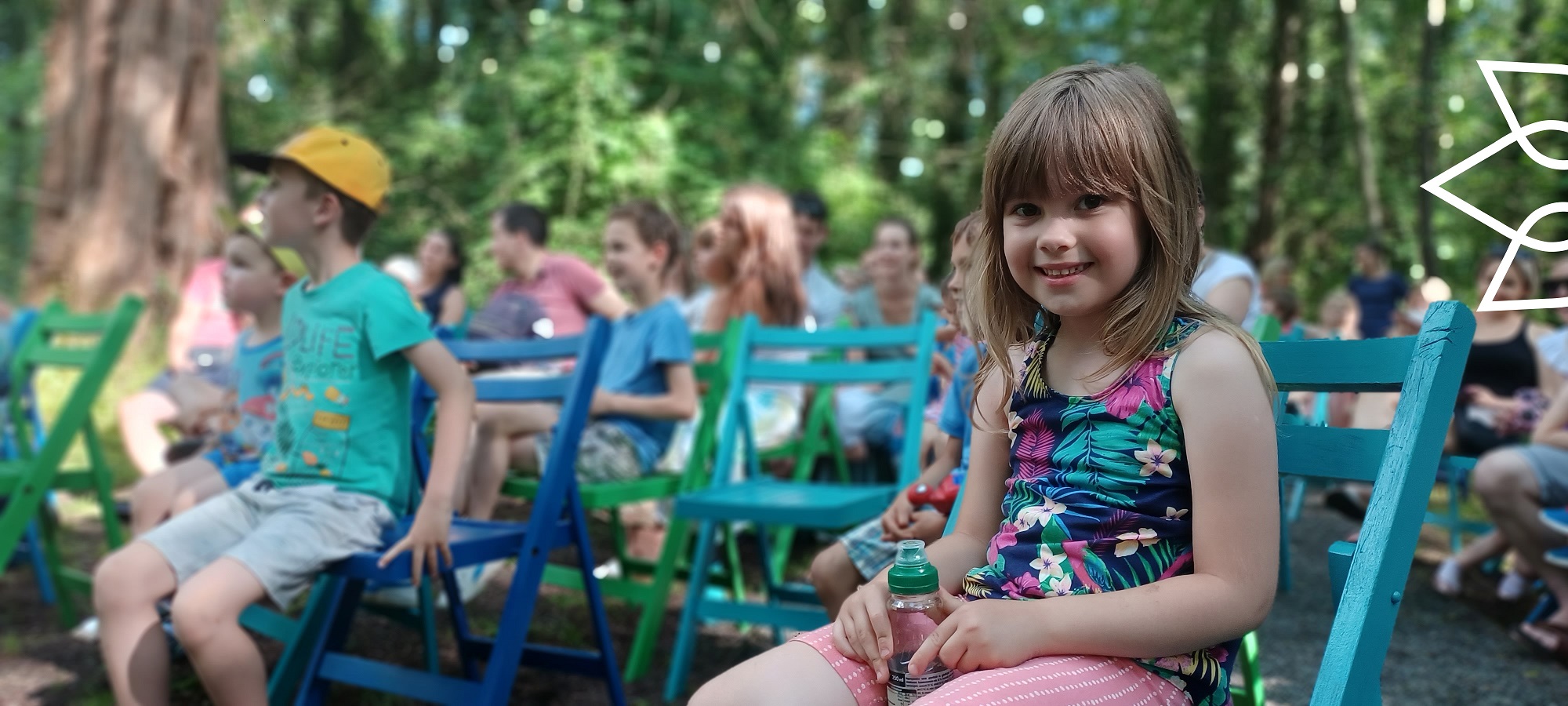
17:00 Light musical afternoon with the Vagabond Trio and the Cséplő-Poór Duo
19:30 Krisztián Grecsó autographs
20:00 Libikóka: Grecsó & Hrutka musical literary evening
6 August, Sunday
10:00 a.m. Musical nursery for the little ones
10:00-16:00 Try it out, experience it, learn it, listen to it, enjoy it, see it... in the tents set up in the museum garden in Egregy: sound bowl session, mandala painting, lifestyle advice, right hemisphere drawing, vegan food, gastro show, craft creative sessions and much more!
10:00-12:00 Playhouse
11:00 Kanga Training
15:00 Tüskevár film HU
16:00 A nagy Ho-Ho-Horgász film (The big angler) HU
17:00 Nature film entitled Wild Hungary HU
Refreshing beverages and delicious snacks every day!
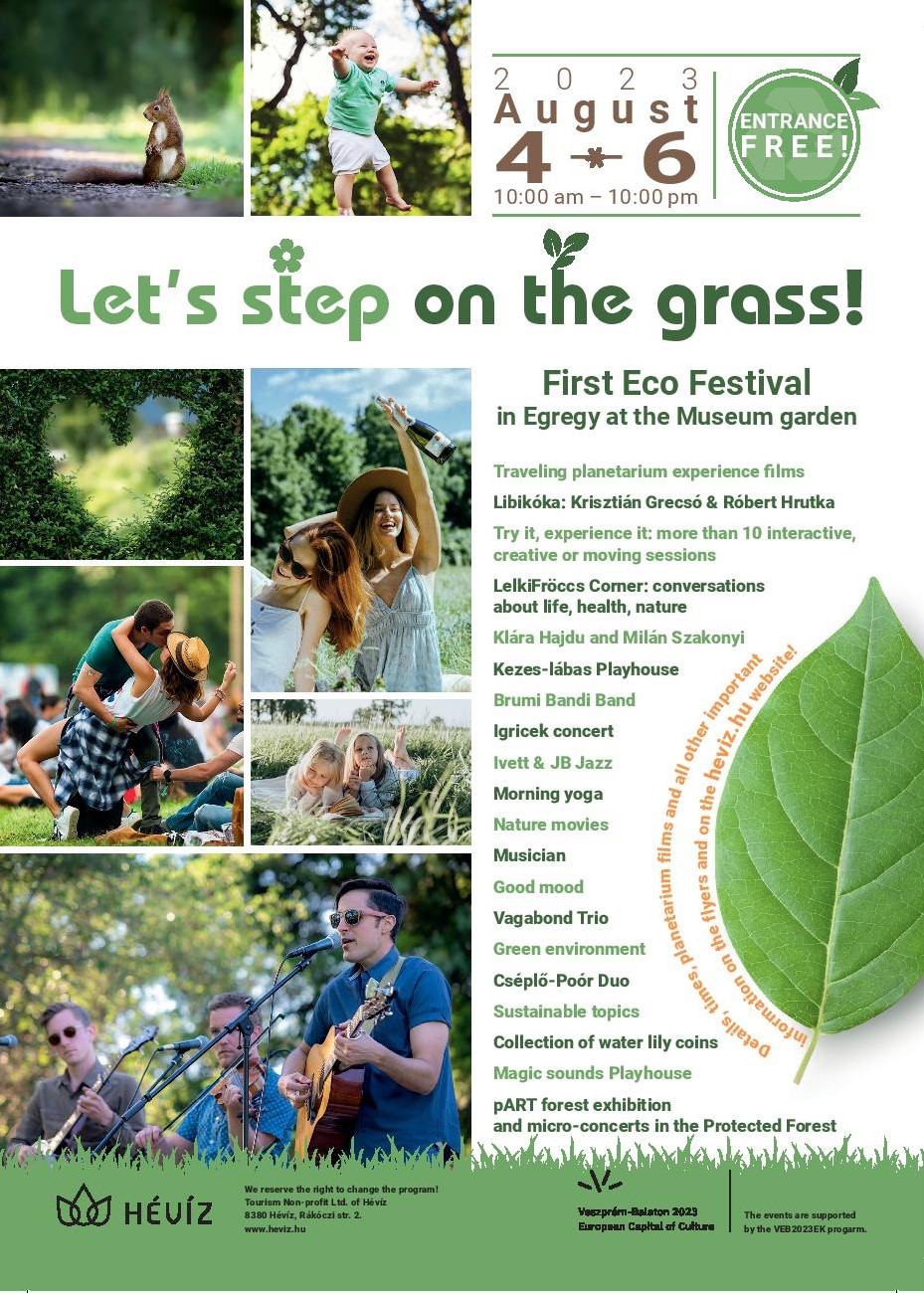
The program is implemented within the framework of the Veszprém Balaton 2023 European Capital of Culture program with the support of VEB2023.

Opening on August 4, 2023 at 4:00 p.m. in Protective forest.
The essence of the pART project is to consider the forest itself as an art space, and let nature itself be the central component of the work of art. Art is not alien to its environment, on the contrary: it is an integral part of the landscape. The creations are not made to last forever, but are volatile and changeable, just like nature. They are part of a permanent cycle, while the forest itself becomes a gallery and also the subject of art.
We will introduce the artists and the exhibition after the opening!
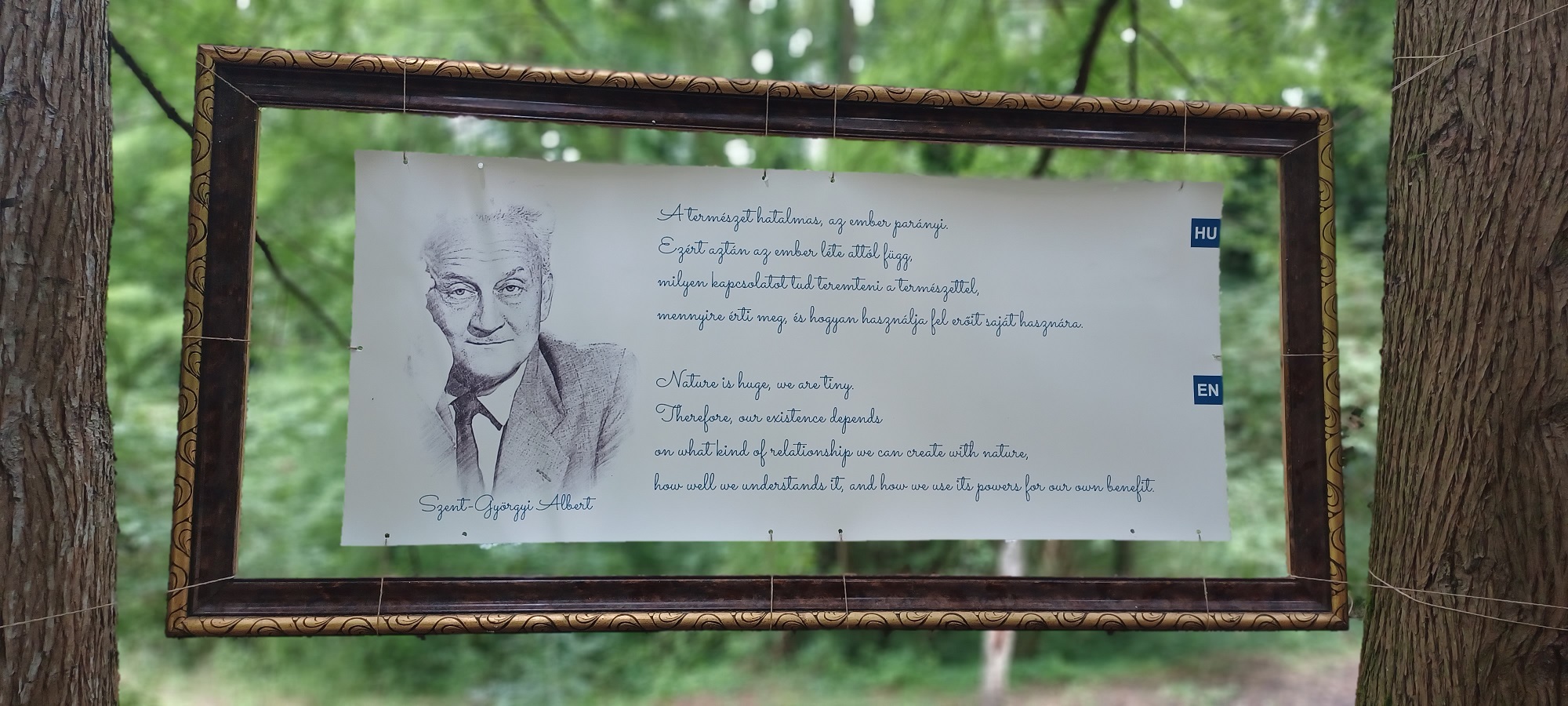
Anyone who knows the area and has seen the exhibition - which is not only about the forest but also about the forest itself - will understand the choice of title. The pART forest exhibit is located on the forest path next to the northern stream of Lake Hévíz. The exhibition of more than 60 images of the wildlife in the nature reserve allows you to walk through the forest and discover the hidden beauties that are usually difficult to see with the naked eye or remain hidden during an ordinary walk. The pictures, stretched on and between trees, show wonderful birds, special plants, small animals and insects. Many of the works are paintings by nature illustrator Márton Zsoldos. The exhibition also includes a few photos taken by nature conservation guards Előd Búzás and Gábor Sinka in the immediate vicinity of Lake Hévíz.
The forest exhibition opens with a wooden gate bearing the motto of the exhibition:
"Open to nature!"
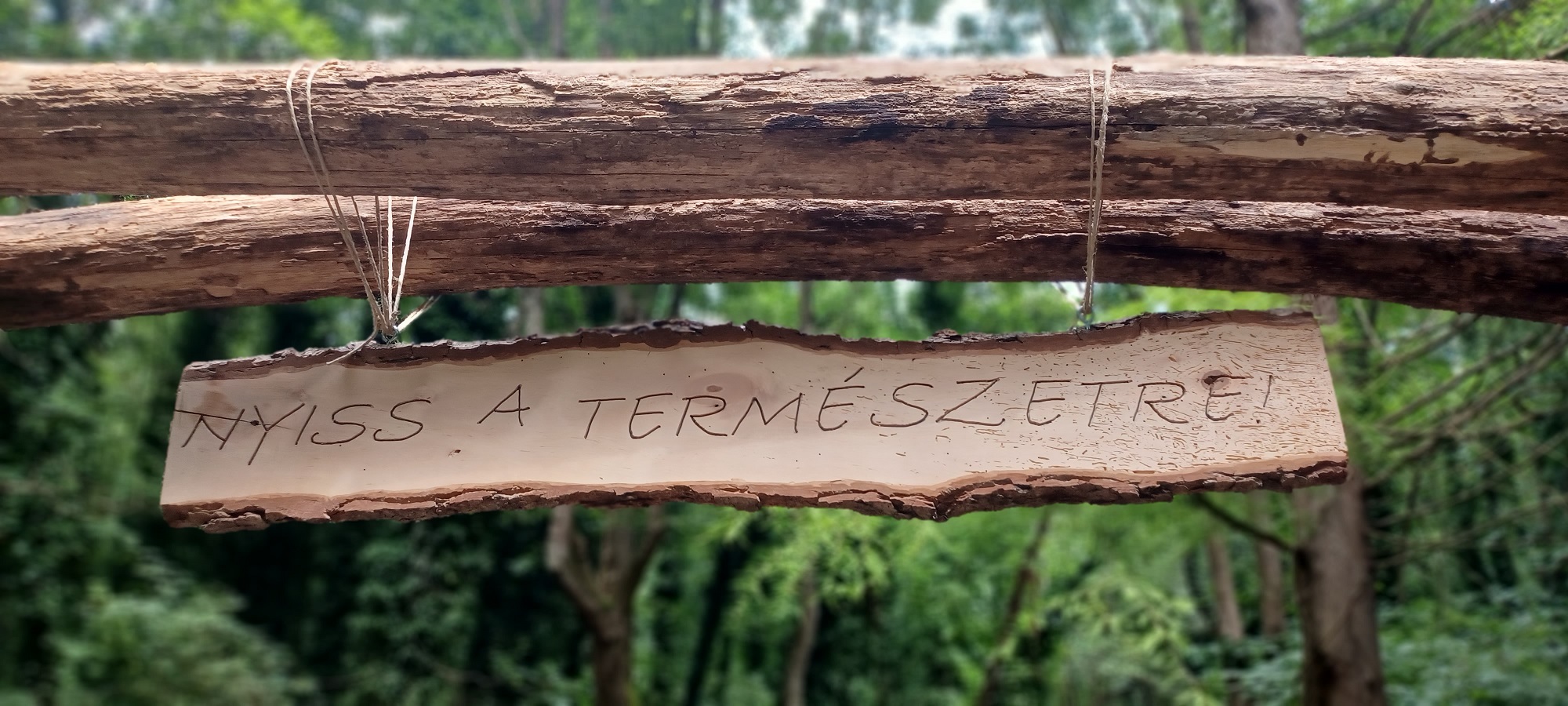
Tamás Pálffy from the organizer Hévízi Turisztikai Np Kft. emphasized that the whole Forest Ministry programme series was organized taking into account the nature conservation, sustainability and green event aspects. Each event tries to leave as small an ecological footprint as possible, and in all its elements it strives to bring people, nature and cultural experiences closer together in a way that only interferes with nature in a small but in no way harmful way.
For this exhibition, recycled wooden picture frames donated by local residents were used, and sugar cane was used for fixing. The forest exhibition is expected to be on display until 30 September, but this may change depending on the use of natural materials and weather conditions. Durability was not an objective in this case.
However, the gate will remain! Because whether or not there is a pART Forest Tour in the Hévíz Forest, the message is always the same: Open to nature!
Galerie

The stage plays are held in the Protective Forest, at the crossing near to the Water Lily Trail.
We can provide 60 places to sit, attendance is free of charge!
All plays are held in Hungarian!
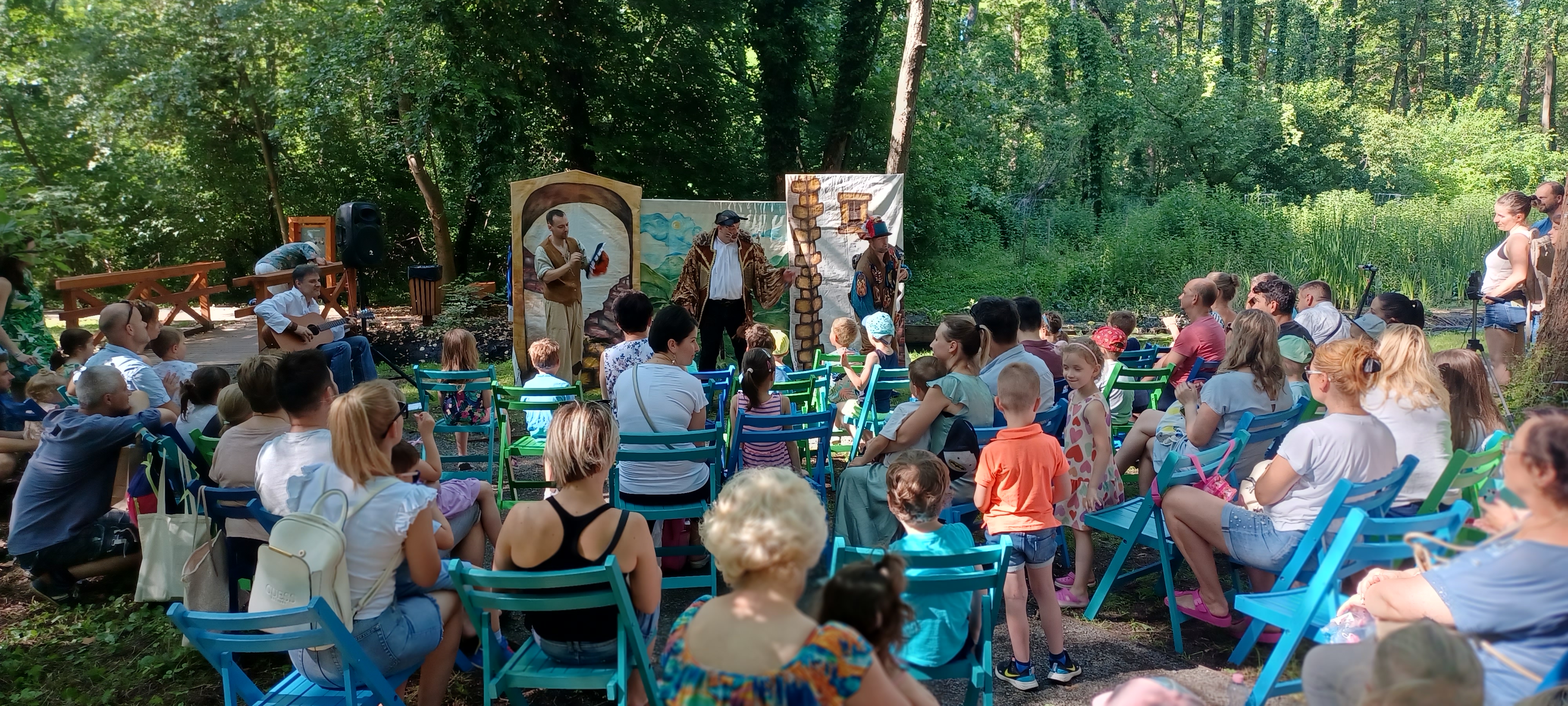
15 July Saturday 17:00 Kacor Király (King Kacor) performance for children - performed by the Hahota Children's Theater
19 August Saturday 16:00 A császár új ruhája (The ceasars new clothes) performance for children - performed by the Hahota Children's Theater
26 September Tuesday 10:00 Mátyás király és az uzsorás (King Matthias and the usury performance for children - performed by the Hahota Children's Theater
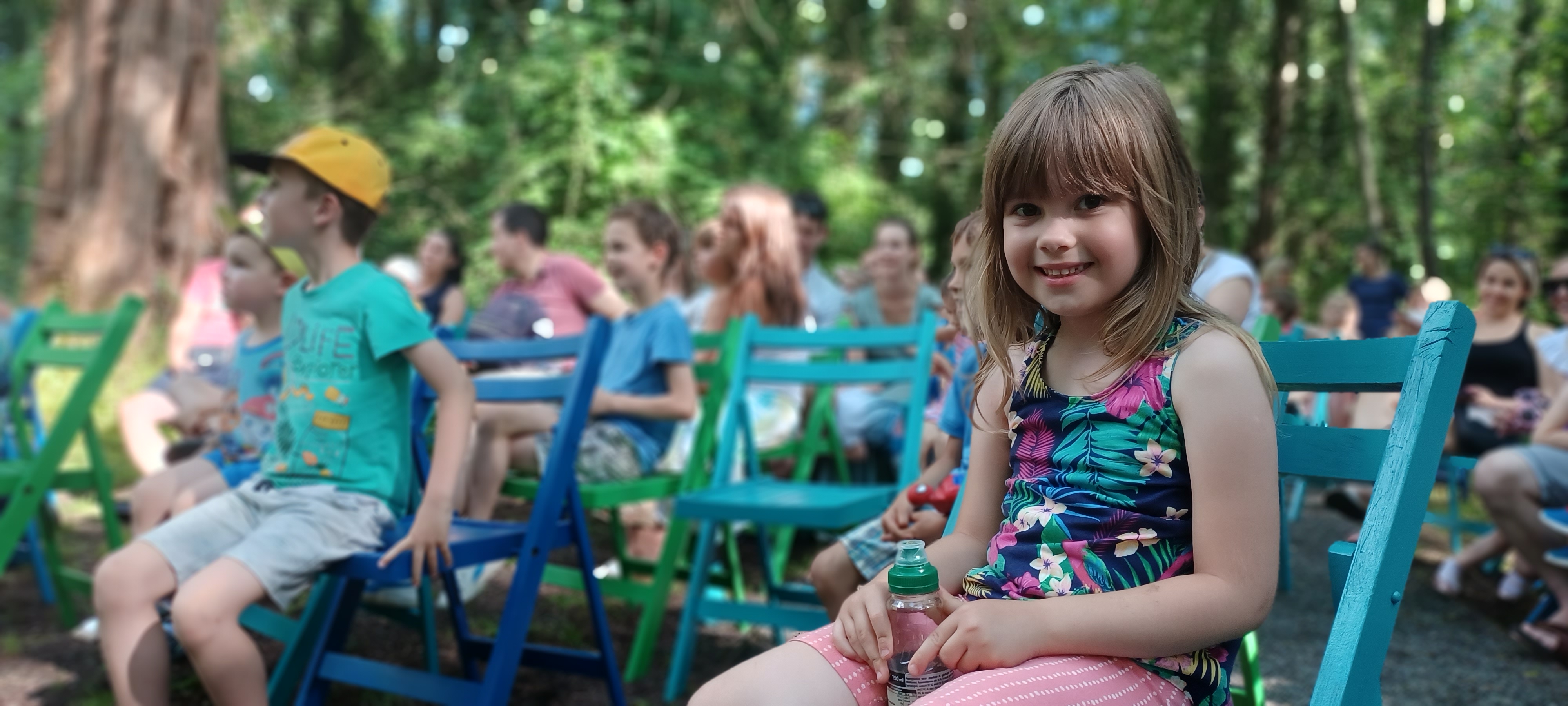

Guided geobotanical tours for adults - geotour in the Protective Forest / 120 min.
Zoltán Tamás Samu geocoach will lead the tours. On the nearly 2-hour geotour, we can get to know many unique species, from the swamp cypress and the protected forest, from the marsh cypress to the waterlilies. What gives the Hévíz forest its speciality and uniqueness? You will get know the landscape specifications! The maximum number of participants is about 15 people.
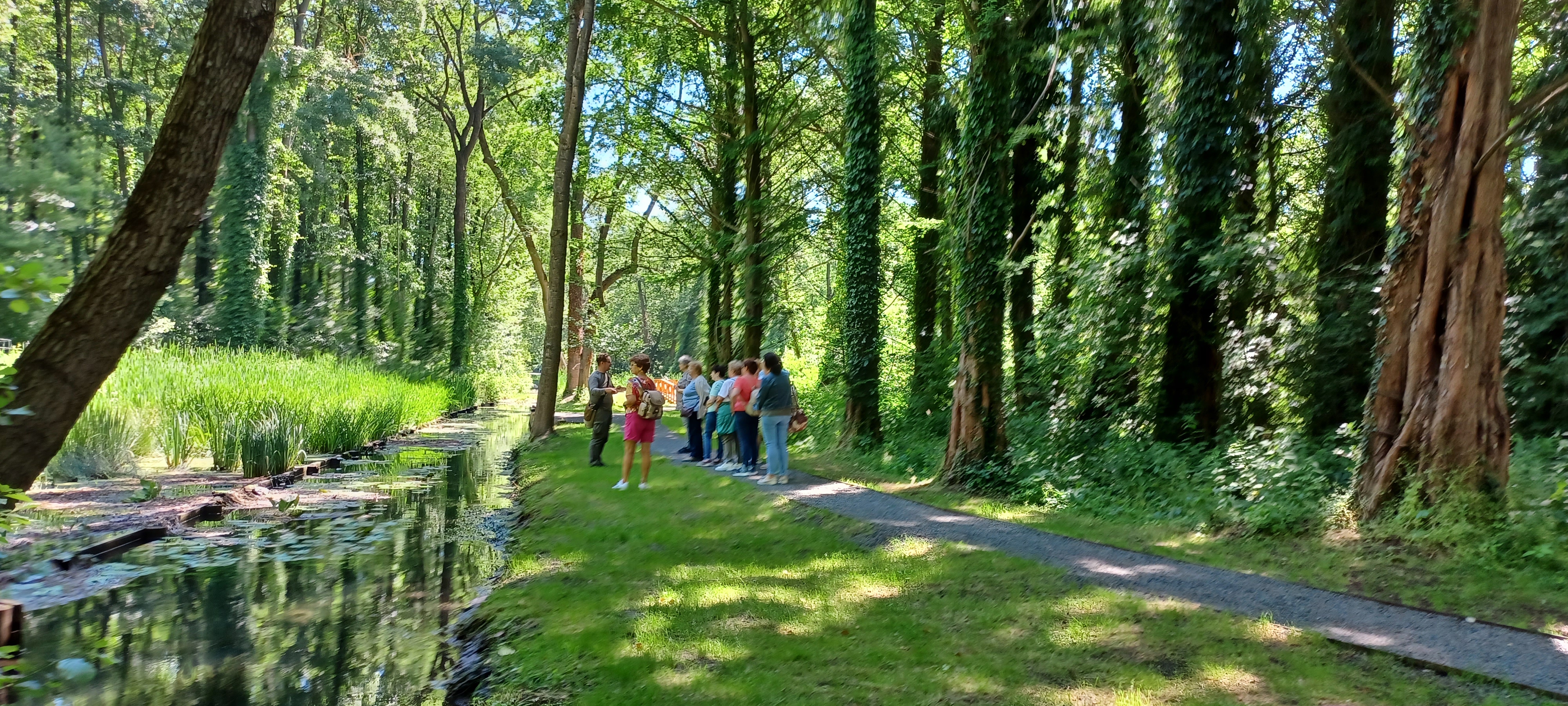
The guided tours are held in Hungarian (except 2 times, which will be held in German!)
30 April 14.00
27 May 16.00
24 June 16.00
14 July 10.00
16 July 10.00 - in German
19 July 11.00
4 August17.00
6 August 10.00- in German
8 September 14.00
7 October 15:00
21 October 15:00
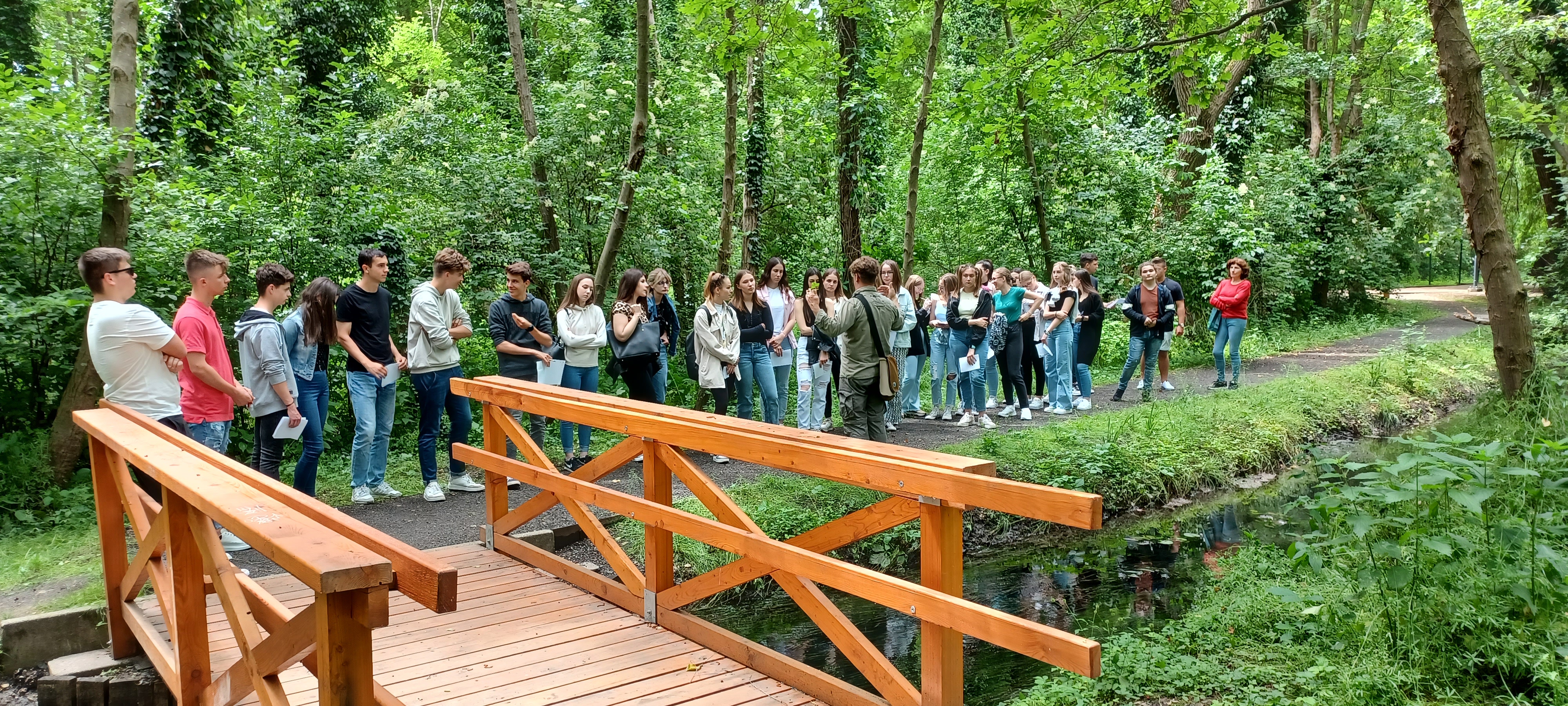
Duration of the tours 120 minutes.
Regitstration
By phone at the tour guide, Tamás Zoltán Samu: +36 30 414 9009 By phone at the Tourinform office every day between 9 a.m. and 5 p.m.: 06 83 540 131
EVERY TOUR IS FOR FREE!- ONLY IN HUNGARIAN (or German) LANGUAGE

The main aim of the program is to see the forest as a protected natural value while we also show it as an existing place for culture and art. We would like to connect the man-nature-art trio to each other to create a new unity with the help of cultural events.
What do WE do to reach this?
- we do not intervene in the circle of nature with our events, we do not create alien objects in the forest
- we do not set stages, lighting or an auditorium: everything stays natural
- we only use portable devices
- the number of attendees are limited to 50 people/event
- we do not spend more than 3 hours in the forest at one occasion
- we do not litter, and we try to reduce the ecological foot print of the event to the minumum
- we honour the rules of the forest - we do not make noise, we do not harm the flora and fauna, we do not pollute the air and we do not disturb the life of the night forest
- we didn't buy new devices for the programs
- we minimalise the usage of plastic
- we give eco-friendly and sustainable gifts for the participants of the guided eco-tours
What can YOU do for our forest?
- don't litter in the forest
- protect the flora and fauna of the forest
- do not leave the beaten path. You can't know if there is a small hedgehog family hiding among the fallen leaves or a new tree is about to grow out of the ground
- be aware that our events are micro events - here experience is more than comfort
- our programs are free of charge, but you can buy a souvenir in the Tourinform Office if you'd like to support what we do
- come to our events on foot or by bicycle or by public transport
- bring water with you and we provide you fresh water to refill your flasks
- take a picture, shoot a video or a selfie during or events or in the Protective Forest and share the experience on social media, use #IloveHévíz
42. Dédi nyomában Biogarden
Last modification: 2025. May. 27. 13:54
Homemade delicacies made from sun-ripened, chemical-free vegetables — straight from the pantry.
Találati relevancia adatok
Tárolt adatok:
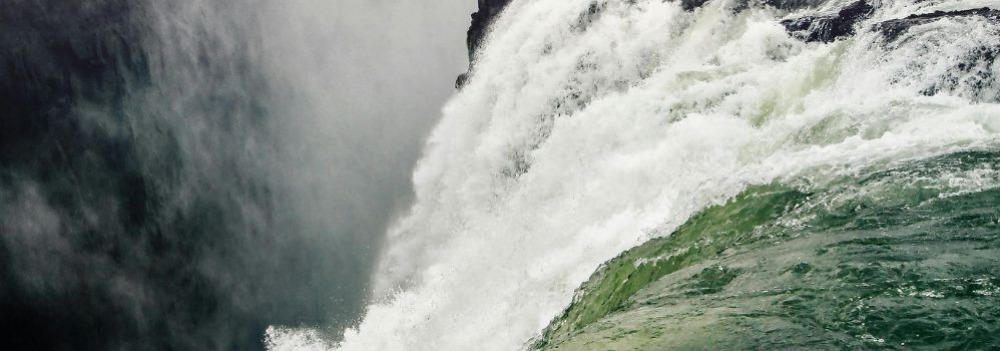
About 10,000 years ago, rapid climate warming triggered a cascade of natural responses: torrential floods, landslides, and intense rock weathering. The landscape we walk on today was not shaped over mere centuries, but by the dramatic forces of climate and water, working together. Did you know that the Zala Valley floor is made up of sediments deposited by a kind of "river of time"? Discover how the Earth’s surface became one of the most sensitive indicators of climate change.
Climate Change: Not Just a Modern Phenomenon
We often associate climate change with contemporary issues, but Earth’s climate has shifted many times throughout its history — sometimes quite rapidly. Within large-scale climatic cycles, alternating periods of warming and cooling have long been part of the planet’s natural rhythm.
When Climate Changes, Everything Reacts
A change in climate sets off a chain reaction of environmental processes. It’s not just animals and plants that respond — so does the landscape itself.
Around 10,000 years ago, as the climate warmed significantly, rainfall became more intense.
More rain meant more erosion: stormwater began washing away sediment from hills and valleys into riverbeds. The rivers, now carrying more water and more sediment, flooded more often and spread these materials across the landscape.
Shaping the Terrain
This had a major impact on topography: the land surface became more fragmented and dynamic. Warming temperatures also sped up chemical and physical weathering, breaking down bedrock and helping fertile soil layers to develop.
In short, natural geological processes that had long been underway suddenly accelerated — and reshaped the surface of the land.
Young Sediments at the Base of the Slopes
Today, in many areas of the region, the lower slopes and valley edges are coated with sediment — debris washed down from higher ground, largely within the last 10,000–20,000 years. In the Zala Valley, for instance, these deposits have spread so far that they now reach the center of the valley floor.
The original bedrock source of these sediments varies: in Zala, it’s typically Pannonian sand (Somló Formation), while in the Keszthely Hills, marine-origin carbonates dominate — mostly dolomite, with some limestone. These sediments now appear as fine gravel, pebbles, or coarse sand, quietly recording the environmental changes of the recent past.
43. Emese Cheese Workshop
Last modification: 2025. May. 27. 13:49
High-quality, artisanal goat milk products straight from sunny Cserszegtomaj — available in both savory and sweet varieties. Find your favorite!
Találati relevancia adatok
Tárolt adatok:
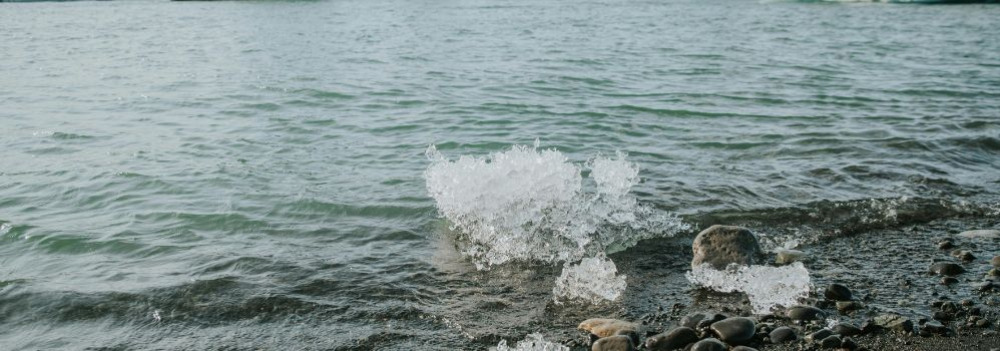
The Life-Giving Winds of the Ice Age: How Loess Shaped the Land
Did you know that Transdanubia’s rich, golden soils are actually a gift from the winds of the Ice Age? Loess isn’t just a dry geological term — it’s an ancient natural recipe that gave rise to some of the most fertile soils in the Carpathian Basin. Where vineyards grow today and birds nest in loess cliffs, strong winds once carried yellow dust across the landscape — for thousands of years. Learn how this unique sediment shaped the land and why loess is still essential for sustainable farming today.
What Is Loess and How Did It Form?
The term loess comes from the German word lose, meaning "loose." Loess is a fine-grained, yellowish sediment that was deposited during the Pleistocene epoch (2.58–0.01 million years ago), particularly during glacial periods. It formed in periglacial environments south of the great Scandinavian ice sheet — cold, dry landscapes with little or no vegetation.
The dust was carried by strong Ice Age winds from floodplains and barren steppes, and slowly accumulated over tens of thousands of years. Eventually, calcium carbonate cemented these layers into loess, which developed characteristic vertical fissures.
It’s important to note that the Pleistocene wasn't a single “Ice Age,” but a period that included alternating cold and warm phases — some even warmer than today.
Loess and the Landscape
Loess gave the Carpathian Basin — especially Transdanubia — its distinct terrain.
Steep loess cliffs (sometimes up to 10 meters high), caves that provide nesting sites for bee-eaters and sand martins, centuries-old sunken roads carved into hillsides, and exposed root systems are all part of the landscape’s geological legacy.
Together, they define the unique character of this region — shaped by time, wind, and stone.
Fertility and Water Retention
Loess-rich areas have produced some of the most fertile soils in the region. Many local producers farm on land that sits atop loess. This creates an excellent foundation for agriculture — not just because of the high humus content, but also because loess has outstanding water-holding capacity. Its vertical pores allow moisture to penetrate deeply and remain in the soil, even during dry periods.
A Modern Echo — Dust from the Sahara
Interestingly, the fine Saharan dust that now reaches Central Europe more frequently can be seen as a modern counterpart to loess-forming material. It’s a reminder that the powerful natural forces that shaped the land long ago are still at work today — just on a different scale.
44. Cserszegtomaj Delights
Last modification: 2025. July. 08. 09:21
Pickles, fermented vegetables, smoky zakuska, homemade jams, and roasted hazelnuts — all crafted from homegrown produce, free of additives, just like grandma used to make.
Találati relevancia adatok
Tárolt adatok:
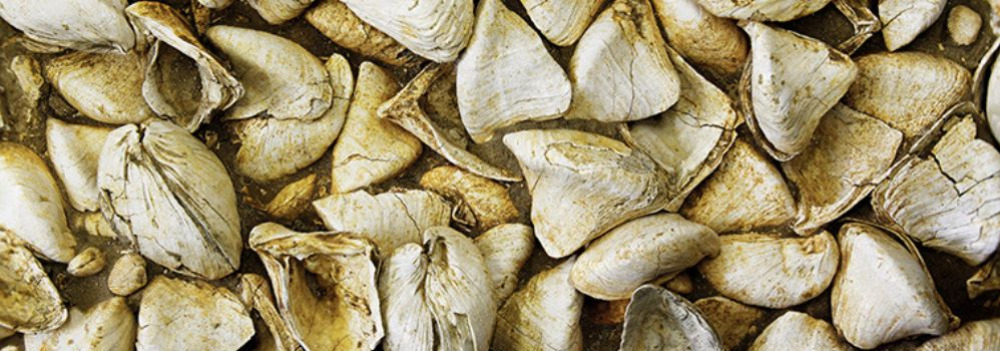
Imagine a vast body of water — over 1,000 meters deep and more than 400 times the size of Lake Balaton — once rippling across this land. The story of the Pannonian Lake is not just a fascinating chapter of geological history, but a legacy that continues to shape the region: it left behind mineral resources, fertile soils, and even inspired legends. Discover how an ancient lake transformed Transdanubia — and why its impact is still felt today.
An Inland Sea for Millions of Years
At its greatest extent, the Pannonian Lake covered an enormous area, far surpassing the size of today’s Balaton. For millions of years (approximately 12 to 8.5 million years ago), it dominated the region. As surrounding mountain ranges gradually rose, the lake became cut off from the world’s oceans. Its water slowly turned fresh, and its basin began to fill with sediments. Because of its isolation, the lake developed a unique ecosystem with many endemic species.
The Lake Didn’t Appear Overnight
The Pannonian Lake didn’t simply “appear” in the Carpathian Basin. Its formation was the result of millions of years of tectonic activity and shifting climate. It emerged as an independent, enclosed body of water — no longer connected to the open seas.
Deep Waters, Varied Shores
In some areas, the lake reached depths of over 1,000 meters. Elsewhere, shallower zones supported lagoons, river deltas, and small, isolated lakes. During high water periods, rocky shorelines formed along the mountain fringes — traces of which can still be found today in the Keszthely Hills and the Mecsek Mountains.
The Lake’s Retreat — and Sediment Legacy
Despite its size, the lake was eventually filled in by immense volumes of sediment, carried mainly by rivers flowing from the Alps and the Carpathians. Over the course of 6.5 million years, it gradually disappeared from the landscape.
What did it leave behind?
Its sediments — composed mostly of sand, clay, and fine silt — became the so-called “Pannonian formations,” which today hold key mineral resources (such as petroleum) and aquifers. These formations define much of the surface geology of Transdanubia, including the Zala Hills.
Fertile soils later formed on the laminated silty and clay-rich deposits of the Somló Formation. Even the legendary “Tihany goat’s hoof” fossils — actually worn shell fragments of the Congeria ungulacaprae mollusk — can still be found embedded in these ancient layers.
The Final Lakes and a Gradual Goodbye
Because most of the sediment entered from the northwest, north, and northeast, the lake slowly retreated toward the south and southeast — as if it were “withdrawing” from what is now Hungary.
Small remnant lakes persisted for much longer in areas of present-day Slavonia (Croatia) and northern Serbia, but due to their different scale, character, and fauna, they are not considered true successors of the ancient Pannonian Lake.

About 10,000 years ago, rapid climate warming triggered a cascade of natural responses: torrential floods, landslides, and intense rock weathering. The landscape we walk on today was not shaped over mere centuries, but by the dramatic forces of climate and water, working together. Did you know that the Zala Valley floor is made up of sediments deposited by a kind of "river of time"? Discover how the Earth’s surface became one of the most sensitive indicators of climate change.
Climate Change: Not Just a Modern Phenomenon
We often associate climate change with contemporary issues, but Earth’s climate has shifted many times throughout its history — sometimes quite rapidly. Within large-scale climatic cycles, alternating periods of warming and cooling have long been part of the planet’s natural rhythm.
When Climate Changes, Everything Reacts
A change in climate sets off a chain reaction of environmental processes. It’s not just animals and plants that respond — so does the landscape itself.
Around 10,000 years ago, as the climate warmed significantly, rainfall became more intense.
More rain meant more erosion: stormwater began washing away sediment from hills and valleys into riverbeds. The rivers, now carrying more water and more sediment, flooded more often and spread these materials across the landscape.
Shaping the Terrain
This had a major impact on topography: the land surface became more fragmented and dynamic. Warming temperatures also sped up chemical and physical weathering, breaking down bedrock and helping fertile soil layers to develop.
In short, natural geological processes that had long been underway suddenly accelerated — and reshaped the surface of the land.
Young Sediments at the Base of the Slopes
Today, in many areas of the region, the lower slopes and valley edges are coated with sediment — debris washed down from higher ground, largely within the last 10,000–20,000 years. In the Zala Valley, for instance, these deposits have spread so far that they now reach the center of the valley floor.
The original bedrock source of these sediments varies: in Zala, it’s typically Pannonian sand (Somló Formation), while in the Keszthely Hills, marine-origin carbonates dominate — mostly dolomite, with some limestone. These sediments now appear as fine gravel, pebbles, or coarse sand, quietly recording the environmental changes of the recent past.
45. Post Covid Care
Last modification: 2022. February. 18. 14:23
Találati relevancia adatok
Tárolt adatok:

After 220 years of medical experience and research, the Traditional Hévíz Therapy became a trademark of Hévíz in 2015. The therapy consists of three basic and four complementary treatments using the healing properties of sulphurous magnesium carbonate water.
Experts have recognized that a significant part of the hydro, movement, physio- and electrotherapies of the Traditional Hévíz Therapy is suitable for the treatment of certain problems of the Post-Covid syndrome. In addition, the mineral content of Lake Hévíz, the evaporating water and the climatic effect of the 60-hectare Protective Forest surrounding the lake are also very effective in achieving the healing effect.
The Post-Covid Care programme will work on the model of the already proven Traditional Hévíz Therapy. Patients arriving in Hévíz with post-Covid-19 symptoms will receive professional and personalised treatments in the comfort of a hotel, under medical supervision. The programme and the quality of the treatments will be identical, regardless of which Hévíz location the patient chooses.

You can achieve a speedy recovery and fuller rehabilitation, as far as possible, not by medication but by a targeted treatment plan (active exercise, passive treatment methods and other physiotherapy techniques). The aim is to preserve the function of the parts of the body that remain intact, to promote the regeneration of damaged tissues and to integrate the recovered functions into the movements of everyday life.
- reducing breathing difficulties
- restoring and improving diaphragm function
- improving chest mobility
- restoring and improving the breathing mechanism
- restoring and improving motor functions
- restoring and improving muscular strength of the skeletal muscles
- improving coordination of movement, balance and proprioception
- restoration and improvement of circulatory functions, endurance
- improving quality of life
- cognitive therapy under the guidance of an occupational therapist
- patient education
- psychic guidance - with the assistance of a psychologist

THE PROGRAMME IS MADE UP OF THE FOLLOWING COMPONENTS:
- Preliminary health survey via an online questionnaire - mandatory element
- Specialist consultation - multiple sessions - mandatory element
- Pre-treatment laboratory and diagnostic tests - optional: can be replaced by medical reports less than four weeks old
- Post-Covid Care treatment programme, consisting of several treatments tailored to the individual - mandatory element
- Accommodation at the provider of the package - optional, the Post-Covid Care programme can also be attended as an outpatient
- Aftercare - an online questionnaire to be filled in after the treatments about the health status achieved as a result of the treatments - mandatory element
WHERE CAN I FILL IN THE PRELIMINARY HEALTH SURVEY?
The survey is the same, but it must always be completed on the website of the hotel where you book your package, as only then will the hotel have access to your protected health information. You can therefore find the questionnaire on the websites of the following accommodation providers:
WHAT PRE-TREATMENT LABORATORY AND DIAGNOSTIC TESTS ARE NEEDED?
- Laboratory tests (blood count, renal function, liver enzymes, C reactive protein, iron panel, thyroid function, D-dimer test)
- ECG test by an internist, cardiologist
- Imaging tests (Chest CT scan, cardiac ultrasound)
- Chest excursion test
- Six-minute walk test
- Oxygen saturation
- Muscle strength measurement of major muscle groups
WHAT TREATMENTS DOES THE POST-COVID CARE TREATMENT PROGRAMME CONSIST OF?
To provide you with a quality service, treatments are carried out according to specific rules by qualified therapists and under constant medical supervision.
Mandatory elements of the treatment
- therapeutic exercises: individually or in a group, in a gym or water according to the patient's condition,
- therapeutic massage,
- electrotherapy (TENS) - pain relief, muscle toning,
- BEMER therapy,
- inhalation,
- CO2 bath
- bath therapy
Treatments recommended as basic treatments, depending on the patient’s condition:
- breathing exercises, chest mobilisation, chest exercises
- general conditioning therapeutic exercises
- muscle strengthening, use of equipment, core training
- plyometric exercises
- development of static and dynamic balance, proprioception: aquatic gymnastics, balance exercises, use of equipment
- circulation, endurance: low, medium, high-intensity aerobic exercises in groups, depending on your condition
- Nordic Walking
- electrotherapy
- massage
- bath therapy
- dry carbon dioxide bath
- bathing in pool
- bathing in Lake Hévíz
Additional options, recommended treatments according to the patient’s condition:
- salt cave
- movement therapy: exercise programmes with physical strain according to the patient's condition, increasing endurance
- patient education: lifestyle and dietary advice
- O2 therapy
- relaxation techniques
- relaxation programmes: Thai Chi, Five Tibetan exercises, yoga...
- stretching
- exercise bicycle in the hotel, electric bicycles for hire at the Tourinform office
- mental health guidance
- outdoor gym at the Lake Baths,
- outdoor aqua fitness at the Lake Baths

DEPENDING ON YOUR CONDITION, THESE ARE THE RESULTS YOU CAN EXPECT:
- Improving the circulation
- Relieving pain
- Relaxing the muscles
- Restoring movement functions lost due to infection
- Relieving contractures caused by infection
- Increasing muscle strength
- Preserving and improving muscle contractility
- Functional learning, occupational therapy (practising practical movements and sequences of movements)
- Training of sensory functions
- Developing dynamic stability
- Preventing the development of complications
- Psychological guidance of the patient
- Achieving self-care
THE EFFECTS OF The Hévíz therapeutic TREATMENT CAN ALSO BE ADDED:
- Maintenance of the function of the articular cartilage
- Mobilisation of the joints
- Release of joint contractures
46. BeReady Project
Last modification: 2025. June. 30. 15:29
Találati relevancia adatok
Tárolt adatok:
The project Be Ready (UrBan hEat islands REsilience, prepAreDness and mitigation strategy) addresses the climate change capacities in the Danube Region taking into account ecosystem-based approaches. The common challenge to be tackled is urban heat islands (UHI). The recent unprecedented heat waves demonstrate the acute need to strengthen the preparedness and adaptive capacity of the society to cope with impacts of climate change and foster resilience at city level.

- provide local and regional authorities with research, assessment and operational instruments to better understand UHI, its drivers, and effects;
- co-create, test and validate jointly developed solutions to mitigate the UHI effects in cities;
- support partner cities to develop and adopt action plans for increased resilience to UHI effects with specific actions to promote green, blue, or white measures.The novel approach to be taken by the project – “green acupuncture” - will allow the partners, both cities and knowledge partners, to take targeted, small but powerful, context-based measures to deal with UHI in critical urban areas. City pilots will test solutions in three areas: “green acupuncture” (vegetation-based interventions); “white acupuncture” (based on innovative surfaces and materials); and “blue acupuncture” (novel uses of water resources).
• Sofia Development Association, Bulgaria – Lead Partner
• DEX Innovation center, Czech Republic
• Association Tehnopol of Galati, Romania
• Chișinău Town Hall, Moldova
• Municipality of Galați, Romania
• Science and Technology Park Nis, Serbia
• City of Nis, Serbia
• City of Zenica, Bosnia and Herzegovina
• Urban Planning Institute of the Republic of Slovenia, Slovenia
• Capital City Podgorica, Montenegro
• University of Natural Resources and Life Sciences, Vienna, Austria
• Slovak University of Technology in Bratislava, Slovakia
• Municipality of Ratiboř, Czech Republic
• South Moravian agency for public innovation JINAG, Czech Republic
• City of Kranj, Slovenia
• Association Bureau for Integration and Social Innovations, Bulgaria
• Development agency North Ltd., Croatia
• Municipality of Hévíz, Hungary
• Small Business Development Foundation of Kisalföld, Hungary
Experts from public institutions, scientific institutions, civil organizations and businesses will come together to learn about the risks of urban heat islands and to actively participate in the further activities of the project, the elimination of heat islands.
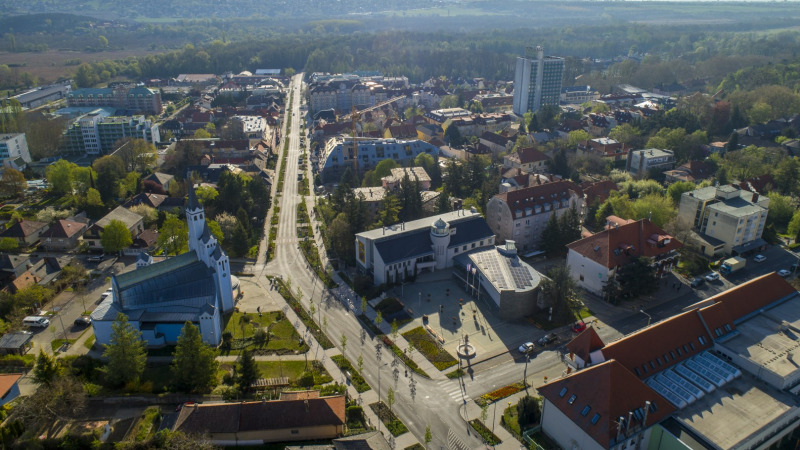
The Be Ready (UrBan Heat Islands Resilience, PrepAreDness and mitigation Strategy) project deals with the climate change capabilities of the Danube region, taking ecosystem-based approaches into account. The common challenge is urban heat islands (UHIs). The recent unprecedented heat waves show the urgent need to strengthen the preparedness and adaptability of society. cope with the impacts of climate change and promote resilience at the urban level.
The Municipality of Hévíz City participates as a consortium partner in the project, where a total of 19 partners from 12 countries joined together to jointly develop solutions to mitigate the effects of heat islands in the urban environment. Partner cities, including Hévíz, develop action plans to tackle urban heat islands through data analysis, urban planning solutions, regulations, increased awareness and infrastructure measures. In connection with this, the local workshop will be held on November 6, 2024, where the work of the relevant professional and civil organizations will begin. During the program, they get to know the overall goals of the project, the research that has already been completed as part of it, the methodology of the risk assessment prepared by the partners, and its use. They create some sort of joint pact to reduce urban heat islands.

Elimination of urban heat islands in order to improve the quality of life of the population and guests.
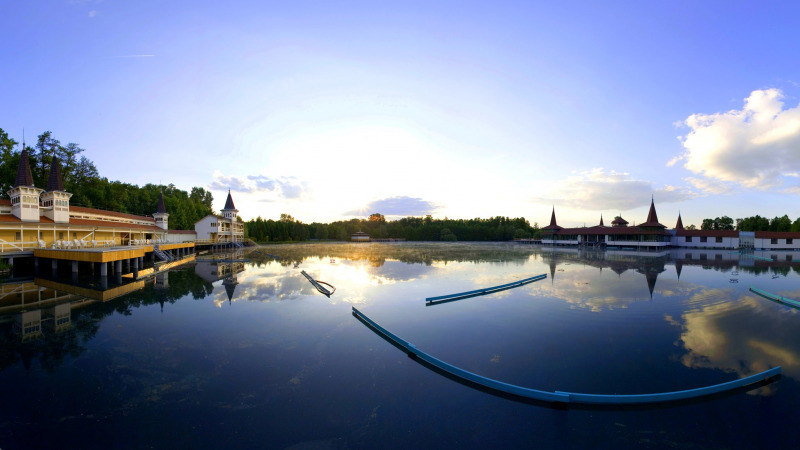
The Be Ready (UrBan Heat Islands - UHI - Resilience, PrepAreDness and mitigation Strategy) project deals with the climate change capabilities of the Danube region. The Municipality of Hévíz City participates as a consortium partner in the project, where a total of 19 partners from 12 countries joined together to jointly develop solutions to mitigate the effects of heat islands in the urban environment.
Representatives of the following organizations participated in the workshop:
Hévíz City Municipality
Hévíz St. Andrew's Rheumatology Hospital and Spa
Balaton Uplands National Park
Hévíz Entrepreneurs' Association
Hévíz Room Publishers' Association
Liget Hévíz Ltd.
Hévíz Television Ltd.
Bonvital Gastro & Wellness Hotel
Noppa Ltd.
Kisalföldi Enterprise Development Foundation
Hévíz Palace Hotel
BOKU University, Vienna
What is the project about in brief?
The partner cities, including Hévíz, develop action plans to combat urban 'hotspots' using data analysis, urban planning solutions, regulations and infrastructure measures.
As the average summer temperature rises, urban heat islands (UHI) are increasingly forming, which pose a health risk to residents and visitors, especially among the oldest and youngest, as well as sick people. The unprecedented heat waves experienced recently show that there is an urgent need to strengthen the preparedness and adaptability of society and to consciously (re)shape our living spaces in defense against the heat.
The aim of the project in Hévíz is to assess the city's hottest spots and develop solutions for their effective cooling or elimination. Efforts must be made to ensure that, within the framework of the 2-year program, there are immediate solutions, unique model projects and long-term strategic proposals at the local level as well.
The BeReady project consists of 5 phases, of which the III. stage preparation is underway in Hévíz. In Phase I, the research institutes assessed the general characteristics of the heat islands and are working on methods to map them. The II. the partners got to know the methods. The current III. with the involvement of the localities, locally affected partners, professional organizations, experts and the population, they will assess their own heat islands based on the methodology and their risk in order to be able to formulate proposals to prevent the formation of heat islands or eliminate existing ones. This will be followed by IV. phase, in which specific tasks and pilot projects must be implemented to reduce heat islands, the results of which will have to be reported and the results published in phase V.

Experts from public institutions, scientific institutions, civil organizations and businesses came together to learn about the risks of urban heat islands and to actively participate in the further activities of the project, the elimination of heat islands on the 6th November 2024 for a local workshop. The crowd of 18 guests got familar with the whole project, and started to learn the about the metodology which will used to measure and collect the local datas to provide the UHI vulnerability of Hévíz.
https://www.heviz.hu/en/news/news/beready-project-in-heviz

As part of the BeReady project (Urban Heat Islands Resilience, Preparedness and Mitigation Strategy), the City of Hévíz has completed a vulnerability assessment related to urban heat islands (UHI).
The assessment was based on a methodology jointly developed by expert partners involved in the project (Urban Planning Institute of Slovenia, BOKU, STUBA, Science and Technology Park Niš), with the goal of reducing risks related to the heat island effect.
The aim of the report is to map the vulnerability and preparedness of the city of Hévíz in the face of increasingly frequent summer heatwaves and extreme temperature events. The city’s analysis was carried out using four key criteria: exposure, sensitivity, preparedness, and adaptive capacity.
The assessment highlighted the urban areas most exposed to the heat island effect—particularly densely built commercial zones and areas with low green space coverage. In the next phase of the project, concrete adaptation and UHI mitigation measures will be developed with the involvement of the local community, paying special attention to the needs of vulnerable population groups.
BeReady – Online Platform for Vulnerability Assessment Tools
Within the framework of the BeReady project, an online platform offering Urban Heat Island (UHI) Vulnerability Assessment Tools has been made available. This platform supports municipalities and professional stakeholders in identifying and managing the risks and vulnerabilities related to the heat island effect.
Its purpose is to assist local authorities and relevant actors in assessing the level of their UHI vulnerability, raising awareness of at-risk groups, and identifying opportunities for development within relevant policies, practices, and in terms of adaptive capacity and preparedness.
The platform offers a simplified self-assessment tool that allows cities to evaluate their UHI exposure, sensitivity, preparedness, and adaptive capacity based on their own data. The methodology is built around four core elements: exposure, sensitivity, preparedness, and adaptive capacity.
In addition, the platform showcases good and promising practices for mitigating UHI impacts and encourages the exchange of experiences and solutions between cities.
Users of the platform also have access to a glossary that helps them understand the technical terms and abbreviations used. Where needed, BeReady partners provide direct support and mentoring through the platform.
The BeReady project aims to provide research-based, assessment, and operational tools to help local and regional authorities better understand the UHI phenomenon, identify its causes, and develop effective adaptation and mitigation strategies.
The platform is available at the following link: https://be-uhi-ready.net/vulnerability-assessment-tools/
47. VIP
Last modification: 2022. September. 26. 09:11
Találati relevancia adatok
Tárolt adatok:
48. CseroSajt
Last modification: 2025. May. 27. 13:53
Smoked parenyica, spiced gomolya, sweet whey cream — if you love authentic flavors, you simply must try CseroSajt!
Találati relevancia adatok
Tárolt adatok:
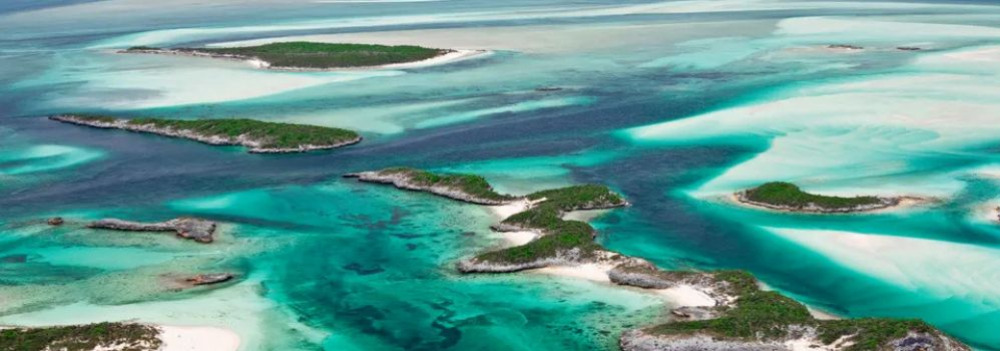
Imagine a tropical sea where the dolomitic peaks of the Keszthely Hills now rise. The landscapes we consider timeless are, in fact, fleeting guests on Earth’s ever-changing stage. How does a shallow tropical sea become Hungarian highlands? Why does dolomite crack? And how does this still influence local farming today? Travel back millions of years into a story written in stone.
The Surface: Only Seemingly Permanent
Mountains, plains, islands, seas, rivers, and lakes may appear permanent within a human lifetime — but from Earth’s perspective, they are only temporary scenes. The rocks that form our planet’s surface are constantly in motion. Like the shattered shell of a boiled egg, tectonic plates drift endlessly atop the semi-fluid mantle beneath them.
Some crash together or sink beneath one another to create towering mountain ranges, while others subside, forming deep trenches or basins that may fill with water. That’s how the dolomite and limestone now forming the Keszthely Hills were once deposited — in the shallow waters of an ancient tropical sea, thousands of kilometers from their present location and long since gone.
The scene would have resembled the crystal-clear shallows of today’s Bahamian paradise.
Volcanoes in the North, a Tropical Sea to the South
While the northern block of the Keszthely Hills is made of relatively young (a few million years old) volcanic rock, the southern section — including Rezi and Cserszegtomaj — is dominated by much older dolomite, formed in those ancient tropical seas. Alongside widespread formations of so-called Main Dolomite, small patches of Rezi Dolomite can also be found — dating back over 200 million years.
The Keszthely Plateau is dissected by a north–south valley system and crisscrossed by micro-tectonic fault lines. Due to the shallow topsoil and varied terrain, more than 70% of the area is forested. Its karst surface experiences year-round water scarcity and has unique ecological features.
The plateau is divided by intermontane basins and bordered by deep tectonic fractures (such as the Hévíz and Ederics faults), making the area seismically sensitive.
Geology and Today’s Land Use
Soils formed on the debris of weathered dolomite provide the natural foundation for land use in the region. Several of our local producers cultivate land along the western edge of the Keszthely Plateau, where farming is defined by the proximity of a highland landscape — a plateau formed of horsts rising 350–440 meters, framed by tectonic fault lines.
49. The land of Rizling
Last modification: 2025. May. 27. 13:53
In “the land of Rizling”, anything can happen — but one thing is certain: an unforgettable wine tasting experience awaits in this hidden corner of the Keszthely Hills.
Találati relevancia adatok
Tárolt adatok:

Imagine a vast body of water — over 1,000 meters deep and more than 400 times the size of Lake Balaton — once rippling across this land. The story of the Pannonian Lake is not just a fascinating chapter of geological history, but a legacy that continues to shape the region: it left behind mineral resources, fertile soils, and even inspired legends. Discover how an ancient lake transformed Transdanubia — and why its impact is still felt today.
An Inland Sea for Millions of Years
At its greatest extent, the Pannonian Lake covered an enormous area, far surpassing the size of today’s Balaton. For millions of years (approximately 12 to 8.5 million years ago), it dominated the region. As surrounding mountain ranges gradually rose, the lake became cut off from the world’s oceans. Its water slowly turned fresh, and its basin began to fill with sediments. Because of its isolation, the lake developed a unique ecosystem with many endemic species.
The Lake Didn’t Appear Overnight
The Pannonian Lake didn’t simply “appear” in the Carpathian Basin. Its formation was the result of millions of years of tectonic activity and shifting climate. It emerged as an independent, enclosed body of water — no longer connected to the open seas.
Deep Waters, Varied Shores
In some areas, the lake reached depths of over 1,000 meters. Elsewhere, shallower zones supported lagoons, river deltas, and small, isolated lakes. During high water periods, rocky shorelines formed along the mountain fringes — traces of which can still be found today in the Keszthely Hills and the Mecsek Mountains.
The Lake’s Retreat — and Sediment Legacy
Despite its size, the lake was eventually filled in by immense volumes of sediment, carried mainly by rivers flowing from the Alps and the Carpathians. Over the course of 6.5 million years, it gradually disappeared from the landscape.
What did it leave behind?
Its sediments — composed mostly of sand, clay, and fine silt — became the so-called “Pannonian formations,” which today hold key mineral resources (such as petroleum) and aquifers. These formations define much of the surface geology of Transdanubia, including the Zala Hills.
Fertile soils later formed on the laminated silty and clay-rich deposits of the Somló Formation. Even the legendary “Tihany goat’s hoof” fossils — actually worn shell fragments of the Congeria ungulacaprae mollusk — can still be found embedded in these ancient layers.
The Final Lakes and a Gradual Goodbye
Because most of the sediment entered from the northwest, north, and northeast, the lake slowly retreated toward the south and southeast — as if it were “withdrawing” from what is now Hungary.
Small remnant lakes persisted for much longer in areas of present-day Slavonia (Croatia) and northern Serbia, but due to their different scale, character, and fauna, they are not considered true successors of the ancient Pannonian Lake.

Imagine a vast body of water — over 1,000 meters deep and more than 400 times the size of Lake Balaton — once rippling across this land. The story of the Pannonian Lake is not just a fascinating chapter of geological history, but a legacy that continues to shape the region: it left behind mineral resources, fertile soils, and even inspired legends. Discover how an ancient lake transformed Transdanubia — and why its impact is still felt today.
An Inland Sea for Millions of Years
At its greatest extent, the Pannonian Lake covered an enormous area, far surpassing the size of today’s Balaton. For millions of years (approximately 12 to 8.5 million years ago), it dominated the region. As surrounding mountain ranges gradually rose, the lake became cut off from the world’s oceans. Its water slowly turned fresh, and its basin began to fill with sediments. Because of its isolation, the lake developed a unique ecosystem with many endemic species.
The Lake Didn’t Appear Overnight
The Pannonian Lake didn’t simply “appear” in the Carpathian Basin. Its formation was the result of millions of years of tectonic activity and shifting climate. It emerged as an independent, enclosed body of water — no longer connected to the open seas.
Deep Waters, Varied Shores
In some areas, the lake reached depths of over 1,000 meters. Elsewhere, shallower zones supported lagoons, river deltas, and small, isolated lakes. During high water periods, rocky shorelines formed along the mountain fringes — traces of which can still be found today in the Keszthely Hills and the Mecsek Mountains.
The Lake’s Retreat — and Sediment Legacy
Despite its size, the lake was eventually filled in by immense volumes of sediment, carried mainly by rivers flowing from the Alps and the Carpathians. Over the course of 6.5 million years, it gradually disappeared from the landscape.
What did it leave behind?
Its sediments — composed mostly of sand, clay, and fine silt — became the so-called “Pannonian formations,” which today hold key mineral resources (such as petroleum) and aquifers. These formations define much of the surface geology of Transdanubia, including the Zala Hills.
Fertile soils later formed on the laminated silty and clay-rich deposits of the Somló Formation. Even the legendary “Tihany goat’s hoof” fossils — actually worn shell fragments of the Congeria ungulacaprae mollusk — can still be found embedded in these ancient layers.
The Final Lakes and a Gradual Goodbye
Because most of the sediment entered from the northwest, north, and northeast, the lake slowly retreated toward the south and southeast — as if it were “withdrawing” from what is now Hungary.
Small remnant lakes persisted for much longer in areas of present-day Slavonia (Croatia) and northern Serbia, but due to their different scale, character, and fauna, they are not considered true successors of the ancient Pannonian Lake.

Imagine a tropical sea where the dolomitic peaks of the Keszthely Hills now rise. The landscapes we consider timeless are, in fact, fleeting guests on Earth’s ever-changing stage. How does a shallow tropical sea become Hungarian highlands? Why does dolomite crack? And how does this still influence local farming today? Travel back millions of years into a story written in stone.
The Surface: Only Seemingly Permanent
Mountains, plains, islands, seas, rivers, and lakes may appear permanent within a human lifetime — but from Earth’s perspective, they are only temporary scenes. The rocks that form our planet’s surface are constantly in motion. Like the shattered shell of a boiled egg, tectonic plates drift endlessly atop the semi-fluid mantle beneath them.
Some crash together or sink beneath one another to create towering mountain ranges, while others subside, forming deep trenches or basins that may fill with water. That’s how the dolomite and limestone now forming the Keszthely Hills were once deposited — in the shallow waters of an ancient tropical sea, thousands of kilometers from their present location and long since gone.
The scene would have resembled the crystal-clear shallows of today’s Bahamian paradise.
Volcanoes in the North, a Tropical Sea to the South
While the northern block of the Keszthely Hills is made of relatively young (a few million years old) volcanic rock, the southern section — including Rezi and Cserszegtomaj — is dominated by much older dolomite, formed in those ancient tropical seas. Alongside widespread formations of so-called Main Dolomite, small patches of Rezi Dolomite can also be found — dating back over 200 million years.
The Keszthely Plateau is dissected by a north–south valley system and crisscrossed by micro-tectonic fault lines. Due to the shallow topsoil and varied terrain, more than 70% of the area is forested. Its karst surface experiences year-round water scarcity and has unique ecological features.
The plateau is divided by intermontane basins and bordered by deep tectonic fractures (such as the Hévíz and Ederics faults), making the area seismically sensitive.
Geology and Today’s Land Use
Soils formed on the debris of weathered dolomite provide the natural foundation for land use in the region. Several of our local producers cultivate land along the western edge of the Keszthely Plateau, where farming is defined by the proximity of a highland landscape — a plateau formed of horsts rising 350–440 meters, framed by tectonic fault lines.
50. Csizmás Syrup
Last modification: 2025. September. 17. 15:27
The unique highlight of Csizmás Syrup is their lightly herbal syrup made from homegrown hemp, but their raspberry, strawberry, and sour cherry syrups are also well worth a taste.
Találati relevancia adatok
Tárolt adatok:

Imagine a vast body of water — over 1,000 meters deep and more than 400 times the size of Lake Balaton — once rippling across this land. The story of the Pannonian Lake is not just a fascinating chapter of geological history, but a legacy that continues to shape the region: it left behind mineral resources, fertile soils, and even inspired legends. Discover how an ancient lake transformed Transdanubia — and why its impact is still felt today.
An Inland Sea for Millions of Years
At its greatest extent, the Pannonian Lake covered an enormous area, far surpassing the size of today’s Balaton. For millions of years (approximately 12 to 8.5 million years ago), it dominated the region. As surrounding mountain ranges gradually rose, the lake became cut off from the world’s oceans. Its water slowly turned fresh, and its basin began to fill with sediments. Because of its isolation, the lake developed a unique ecosystem with many endemic species.
The Lake Didn’t Appear Overnight
The Pannonian Lake didn’t simply “appear” in the Carpathian Basin. Its formation was the result of millions of years of tectonic activity and shifting climate. It emerged as an independent, enclosed body of water — no longer connected to the open seas.
Deep Waters, Varied Shores
In some areas, the lake reached depths of over 1,000 meters. Elsewhere, shallower zones supported lagoons, river deltas, and small, isolated lakes. During high water periods, rocky shorelines formed along the mountain fringes — traces of which can still be found today in the Keszthely Hills and the Mecsek Mountains.
The Lake’s Retreat — and Sediment Legacy
Despite its size, the lake was eventually filled in by immense volumes of sediment, carried mainly by rivers flowing from the Alps and the Carpathians. Over the course of 6.5 million years, it gradually disappeared from the landscape.
What did it leave behind?
Its sediments — composed mostly of sand, clay, and fine silt — became the so-called “Pannonian formations,” which today hold key mineral resources (such as petroleum) and aquifers. These formations define much of the surface geology of Transdanubia, including the Zala Hills.
Fertile soils later formed on the laminated silty and clay-rich deposits of the Somló Formation. Even the legendary “Tihany goat’s hoof” fossils — actually worn shell fragments of the Congeria ungulacaprae mollusk — can still be found embedded in these ancient layers.
The Final Lakes and a Gradual Goodbye
Because most of the sediment entered from the northwest, north, and northeast, the lake slowly retreated toward the south and southeast — as if it were “withdrawing” from what is now Hungary.
Small remnant lakes persisted for much longer in areas of present-day Slavonia (Croatia) and northern Serbia, but due to their different scale, character, and fauna, they are not considered true successors of the ancient Pannonian Lake.
51. Hotelservices for non-hotel guests
Last modification: 2025. September. 26. 11:09
Találati relevancia adatok
Tárolt adatok:
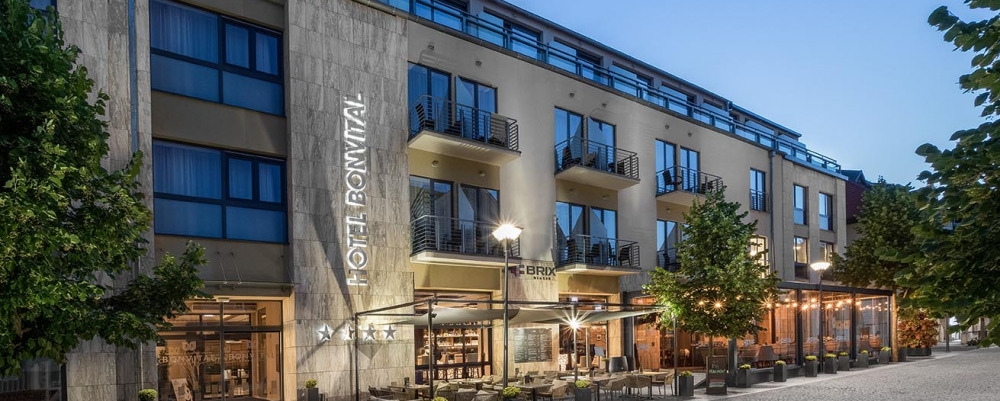
Bonvital Wellness & Gastro Hotel
Address: 8380 Hévíz, Rákóczi Street 16–18
Tel.: +36 83 900 120
Wellness Use
Price: HUF 16,900 / person – can be purchased online via the hotel’s website or at the reception
Includes:
-
Full-day use of the wellness and sauna area (8:00 AM – 8:00 PM)
-
Refreshment drink at the wellness area
-
3-course lunch menu at our Brix Bistro
-
Choice of menus:
-
Menu A: Daily cream soup, Caesar salad + grilled chicken, daily dessert
-
Menu B: Daily cream soup, Club sandwich + French fries, daily dessert
-
-
1 spa treatment of your choice:
-
Swedish massage (25 min), or
-
Relaxing face, neck and décolleté massage (25 min)
-
-
Towel use included
Validity & Payment:
-
Valid for 6 months from date of issue (available Mon, Tue, Wed, Thu, Sun)
-
Not bookable: 23–26 Oct 2025, 31 Oct–2 Nov 2025, 19–29 Dec 2025, 29 Dec 2025 – 2 Jan 2026
-
Accepted payment methods: OTP SZÉP Card, K&H SZÉP Card, MBH SZÉP Card, Bank Transfer Gift Voucher Payment, Simple Pay – Online card payment for vouchers
Brix Bistro Opening Hours
Monday–Sunday: 10:00 AM – 10:00 PM
À la carte: 12:00 PM – 9:30 PM
Medical Services
Our specialist: Dr. Zsolt Parczen – Physiotherapist, Rehabilitation Specialist, Rheumatologist, Internist
Consultation hours: Monday, Wednesday, Friday
Prices:
-
Specialist consultation – HUF 25,400
-
Follow-up consultation – HUF 15,000
-
Prescription – HUF 5,000
Available Treatments:
-
Four-cell galvanic bath: 15 min – HUF 7,800
-
Electric tub bath: 20 min – HUF 8,900
-
Mud bath: 20 min – HUF 10,200
-
Sulphur bath: 20 min – HUF 10,200
-
Underwater jet massage (tangentor): 20 min – HUF 8,900
-
Weight bath: 20 min – HUF 9,900
-
Alternating bath: 20 min – HUF 10,200
-
Ultrasound: 10 min – HUF 9,000
-
Interference: 15 min – HUF 9,000
-
TENS: 15 min – HUF 9,000
-
Diadynamic: 10 min – HUF 9,000
-
Magnetic ring therapy: 30 min – HUF 7,800
-
Shockwave therapy: 10 min – HUF 8,900
-
Soft laser therapy: 20 min – HUF 7,800
-
Cryotherapy (cold air): 10 min – HUF 7,800
-
Therapeutic massage: 20 min – HUF 11,000
-
Medicinal mud pack: 20 min – HUF 11,900
-
Sulphur pack: 60 min – HUF 9,000
-
PCP pack: 60 min – HUF 9,000
Prices valid from 01.08.2025 until withdrawn. Subject to change.
Booking: Spa Reception: +36 83 900 126 | spa@bonvital.hu
Packages
-
Introductory Cure Package: 1 specialist consultation + 4 treatments prescribed by the doctor – HUF 60,300
-
1-Week Cure Package: 1 specialist consultation + 6 treatments prescribed by the doctor + 10% discount on Hévíz Spa ticket – HUF 75,300
-
2-Week Cure Package: 1 specialist consultation + 12 treatments prescribed by the doctor + 15% discount on one Beauty treatment + 1 Hévíz Spa ticket – HUF 119,700
Prices valid from 01.08.2025 until withdrawn. Subject to change.
Booking at Spa Reception: +36 83 900 126 | spa@bonvital.hu
Evening Programs with Live Music
Themed gastronomic weekends every Friday to Sunday – announced on our website and Facebook page.
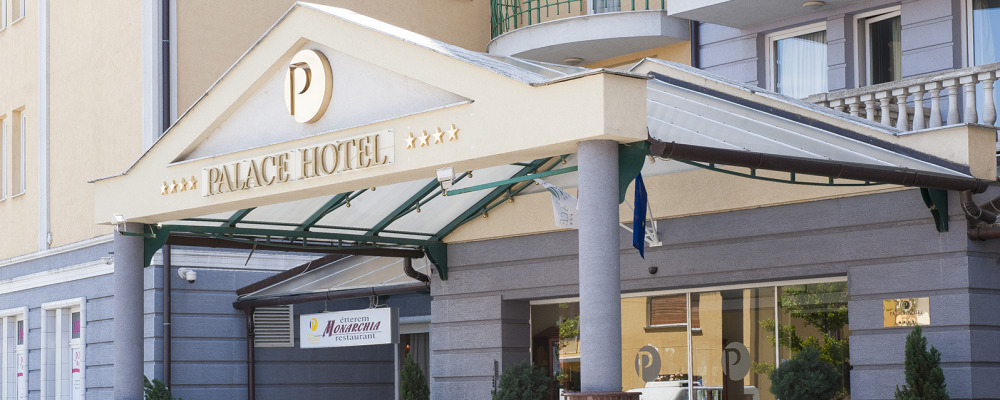
Hotel Palace Hévíz
Address: 8380 Hévíz, Rákóczi Street 1–3
Tel.: +36 83 542 140
Dining
-
External breakfast (buffet): HUF 8,990 / person
-
External dinner (buffet, drinks not included): HUF 12,500 / person
-
Lunch: à la carte or grill lunch – daily soup + choice of grilled dish with salad and side dish, served daily from 12:00–14:00 in the Monarchia Restaurant: HUF 6,990 / person
Medical Department
Prices for Treatments:
-
Specialist consultation: HUF 18,900
-
Follow-up consultation: HUF 10,900
-
1-week cure: HUF 55,900 – includes 6 treatments and 1 medical consultation
-
Mini cure: HUF 42,900 – includes 4 treatments and 1 medical consultation
-
Cure: HUF 79,900 – includes 10 treatments and 1 medical consultation
-
2-week cure: HUF 92,900 – includes 12 treatments, 1 medical consultation and 1 follow-up consultation
-
Therapeutic massage: HUF 7,700 / 20 minutes
Mechanotherapy
-
Therapeutic massage – HUF 7,700 / 20 minutes
-
Ultrasound – HUF 5,500 / 10 minutes
-
Sonophoresis – HUF 5,500 / 10 minutes
Electrotherapy
-
Interference – HUF 5,500 / 10 minutes
-
TENS therapy – HUF 5,500 / 10 minutes
-
Diadynamic therapy – HUF 5,500 / 10 minutes
-
Four-cell galvanic bath treatment (Hydrogalvanic) – HUF 5,500 / 10 minutes
Therapeutic Packs
-
Mud pack – HUF 7,300 / 20 minutes
-
Fluor pack – HUF 7,100 / 20 minutes
-
Sulphur pack – HUF 7,100 / 60 minutes
-
Ritex pack – HUF 7,100 / 20 minutes
-
PCP pack – HUF 7,100 / 20 minutes
-
Antiphlogistic (anti-inflammatory) pack – HUF 7,100 / 120 minutes
Magnet Therapy
-
Magnetic mat – HUF 4,900 / 12 minutes
Inhalation
Choice of:
-
Medicinal inhalation – HUF 2,900 / 10 minutes
-
Chamomile inhalation – HUF 2,900 / 10 minutes
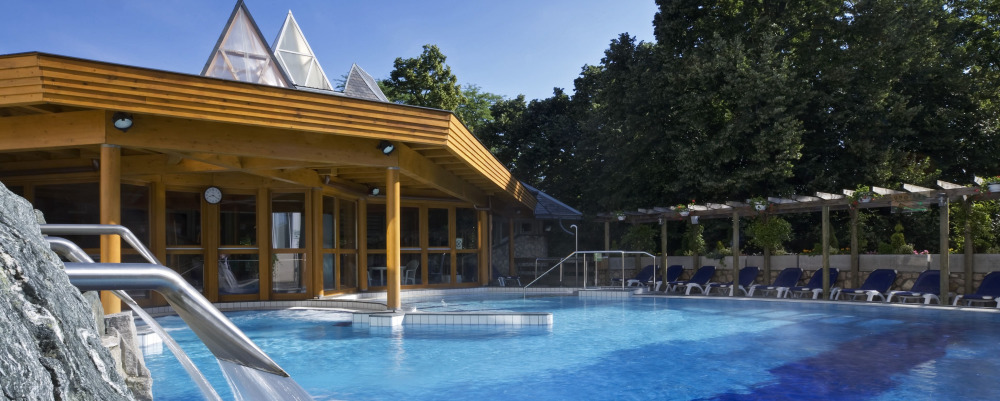
ENSANA Thermal Hévíz
Address: 8380 Hévíz, Kossuth Lajos Street 9
Tel.: +36 83 889 444
Wellness
Single-entry bath ticket for the use of the wellness area – prior booking by phone is recommended.
-
Day ticket: HUF 9,000
-
Afternoon ticket (after 5 PM): HUF 5,900
More information about the wellness services:
https://ensanahotels.com/en/wellness
Dining
Advance table reservation is recommended.
Tel.: +36 30 647 6517
-
Buffet dinner: HUF 11,000 + 12% service charge (price excludes drinks)
Medical Services
Cure packages and individual treatments are also available.
Advance booking by phone is required!
Tel.: +36 83 889 477
More information about medical services:
https://ensanahotels.com/en/medical-treatments/medical-services
Live Music Evening Programs
Live music events take place four evenings a week in the hotel’s Cyclamen Bar:
Tuesday, Thursday, Friday and Saturday, from 7:00 PM to 11:00 PM.
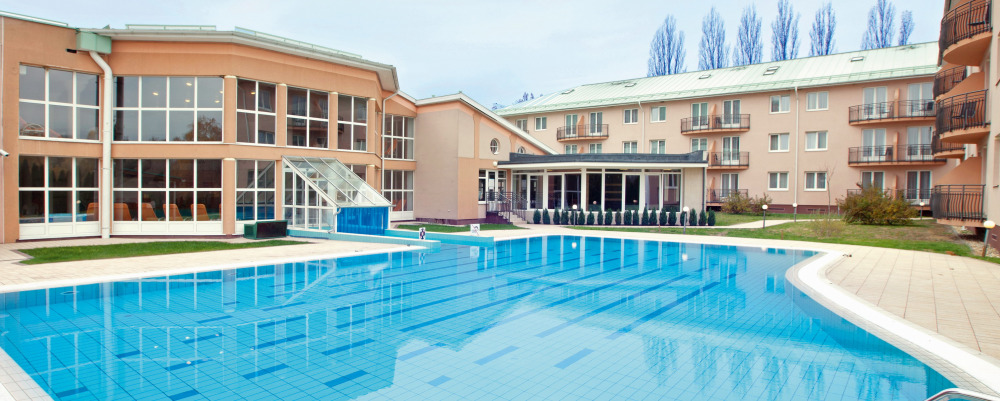
Hotel Európa Fit
Address: 8380 Hévíz, Jókai Street 3.
Phone: +36 30 501 100
Wellness
The daily wellness ticket includes the following services:
Unlimited use of the wellness area:
-
Indoor adventure pool
-
Whirlpool
-
Children's paddling pool
-
Indoor thermal pool
-
Brand-new outdoor thermal pool
-
Indoor and outdoor swimming pool (open all year)
-
Outdoor Acapulco Family Adventure Pool with 270 m² water surface (summer season)
Modernized Ground Floor Sauna World (accessible in swimwear):
-
Finnish saunas
-
Steam bath
-
Herbarium
-
Infrared sauna
-
Salt chamber
ReneSanarium – Upstairs Naturist Sauna Area:
-
Finnish panorama sauna
-
Steam bath
-
Tropical experience shower
-
Relaxation area
-
Guided sauna infusions (for an additional fee)
-
Use of locker
-
Towels provided (against deposit)
Daily Wellness Ticket Prices:
Adult price:
-
Monday – Thursday: 7,900 HUF / person
-
Friday – Sunday: 9,900 HUF / person
Children's price:
-
Free of charge up to 5 years old
-
Ages 5–12:
-
Monday – Thursday: 3,950 HUF / person
-
Friday – Sunday: 4,950 HUF / person
-
-
Children over 12 years pay the full adult price.
Wellness Opening Hours:
-
Sunday – Thursday: 7:00 – 20:00
-
Friday – Saturday: 7:00 – 21:00
-
Indoor Thermal Pool: 8:00 – 19:00
-
Outdoor Thermal Pool: 10:00 – 20:00
-
Ground Floor Sauna World: 8:00 – 19:00
-
Upstairs Naturist Sauna World: 14:00 – 19:00
Important Information:
The capacity of our wellness area is limited; external guests can only be accommodated depending on hotel occupancy.
Please inquire about availability in advance at:
+36 83 501 126
During holiday periods and in the high summer season, we cannot accommodate external guests.
Health Center – Private Medical Services
Diabetology
-
Consultation: Monday 9:00–15:00
ENT (Ear, Nose, Throat)
-
Consultation: Saturday 9:00–14:00
Urology
-
Consultation: Saturday 9:00–16:00
Endocrinology
-
Consultation: Monday 9:00–15:00
Surgery
-
Consultation: Tuesday 9:00–12:00
Gynecology
-
Consultation: Friday 9:00–15:00
-
Saturday 9:00–15:00
Orthopedics
-
Consultation: Friday 16:00–18:00
Story Pedagogy Sessions
-
Baby-mommy group: Saturday 15:00
-
Preschool / primary school groups: Saturday 16:00 or Sunday 11:00
Dietitian
-
Consultation: Wednesday 9:00–16:00
Rheumatology
-
Consultation: Tuesday–Friday 11:00–14:00
Psychology
-
Consultation: Saturday 9:00–12:00
Ultrasound Diagnostics
-
Consultation: Monday 8:00–12:00
Intimate Laser Treatments
-
Consultation: Friday 9:00–15:00
Synlab Laboratory Tests
-
Blood collection, sample drop-off: Tuesday, Thursday 7:00–10:00, Saturday 7:15–10:00
HPV Screening
-
Consultation: Friday 9:00–15:00
-
Saturday 9:00–15:00
Dentistry
-
Consultation: Monday–Friday 9:00–12:00
Gynecological One-Day Surgery
-
Consultation: Thursday 9:00–14:00
Cardiology
-
Consultation: Friday 14:00–18:00
One-Day Surgery
-
Consultation: Tuesday 9:00–12:00
Internal Medicine
-
Consultation: Friday 14:00–18:00
Dermatology
-
Consultation: Monday 8:00–11:00
-
Thursday 9:00–14:00
Laser Snoring Treatment – NightLase
-
Consultation: Saturday 9:00–14:00
PRP Treatment
-
Consultation: Tuesday 9:00–15:00
-
Friday 16:00–18:00
Facial and Body Aesthetic Laser Treatments
-
Consultation: Tuesday 9:00–12:00
-
Thursday 9:00–14:00
Beauty Treatments for External Guests
Brand-new facial treatments:
-
DX Glow Defence Intensive Treatment (70') – Sothys: 32,500 HUF
-
Pigmentation Management (60') – Sothys: 29,600 HUF
-
Cryo Eye Firming Eye Treatment (40') – Sothys: 15,100 HUF
-
Thesera L Lifting Treatment (Bio Thread Lift) (90') – Sothys: 49,900 HUF
Popular treatments recommended by our beauticians:
-
Radiofrequency Mesotherapy Face & Neck + Radiofrequency Face & Neck + Firming Mask: 45,200 HUF
-
Anti-cellulite Firming Treatment: 27,700 HUF
-
Radiofrequency Body Treatment (thigh, buttocks, abdomen): 21,900 HUF / area
-
Regenerating, Firming Abdominal Treatment: 18,300 HUF
Therapeutic Treatments for External Guests
Unique therapeutic treatments:
-
Shockwave Therapy: 8,400 HUF
-
Inversion Table: 8,400 HUF
-
BEMER Magnetotherapy: 8,400 HUF
-
Repuls Therapy: 9,900 HUF
Recommended therapy packages:
-
1 medical consultation + 6 treatments: 71,900 HUF
-
1 medical consultation + 10 treatments: 116,900 HUF
-
1 initial + 1 closing consultation + 20 treatments: 224,900 HUF
Discounted Lake Bath Ticket
Complete your healing journey with a dip in the unique, healing waters of Lake Hévíz!
-
3+1 hour ticket: 4,050 HUF (instead of 4,500 HUF)
-
When purchasing a 3-hour ticket, an additional 1 hour of bathing is provided free of charge.
Dining
Depending on availability, we also welcome external guests in our Citrus Restaurant during breakfast, lunch, and dinner.
Team Building & Events
Corporate team-building cooking experiences – part of our FitKitchen offer.
To inquire or register, please contact us at:
Email: business@europafit.hu
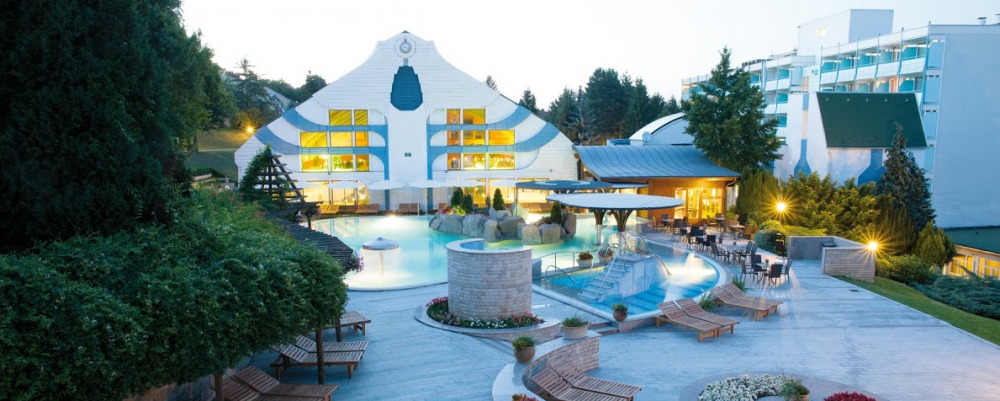
Hotel Carbona Thermal Spa
Address: 8380 Hévíz, Attila Street 1
Phone: +36 83 501 500
For current availability and options, please inquire in advance at Reception:
+36 83 501 522
Opening Hours
-
Swimming Pool: 7:00 – 21:00
-
Sauna Oasis & Textile Sauna: Mon–Sat 10:00 – 21:00 | Sun 8:00 – 21:00
-
Thermal Bath: Sun–Thu 7:00 – 18:00 | Fri–Sat 7:00 – 19:00
-
Outdoor Adventure Pool: 7:00 – 21:00
Winter Season:
Mon–Thu 10:00–18:00 | Fri 10:00–21:00 | Sat 7:00–21:00 | Sun 7:00–18:00
Summer Season:
7:00 – 21:00
Wellness Brunch
Price: 19,600 HUF / person / occasion
Includes all-day use of the swimming pool, sauna oasis, adventure pool, as well as a delicious lunch.
Children’s price:
-
Free of charge up to 6 years old
-
Ages 6–12: 9,800 HUF
-
Over 12 years: full price applies
Wellness Day Ticket
-
Adventure Pool & Swimming Pool Day Ticket: 9,400 HUF / person / occasion
Includes access to the outdoor adventure pool, 25 × 12.5 m swimming pool, and sauna oasis.
Children’s price:
-
Free up to 6 years
-
Ages 6–14: 4,600 HUF
-
Over 14 years: full price applies
-
Thermal Bath Day Ticket: 5,500 HUF / person / occasion
(Children under 14 years are not allowed in the thermal bath area.) -
Combined Ticket (adventure pool, swimming pool, and thermal bath): 12,000 HUF / person / occasion
Wellness Pass
Afternoon Pass: 28,200 HUF / person / 6 occasions
Includes access from 16:00 to the following:
-
Outdoor adventure pool
-
25 × 12.5 m swimming pool
-
Sauna oasis
Valid within 1 year from the date of purchase.
Bathing times for pass holders:
-
Adventure Pool: from 16:00 until closing time
-
Swimming Pool & Sauna Oasis: 16:00 – 21:00
Traditional Hévíz Cure
For our offer, please send an email to hotel@carbona.hu
Wellness, Medical, and Beauty Services
Our hotel’s services – including wellness treatments, medical therapies, and treatments at our Esteticum Beauty Salon – can also be used without accommodation booking.
For appointment booking, please visit the spa or beauty reception desks or call:
-
SPA Reception: +36 83 501 530
-
Esteticum Beauty Salon: +36 83 501 578
Further information:
https://carbona.hu/spa/wellness/
https://carbona.hu/spa/gyogyaszat/
https://carbona.hu/spa/beauty/
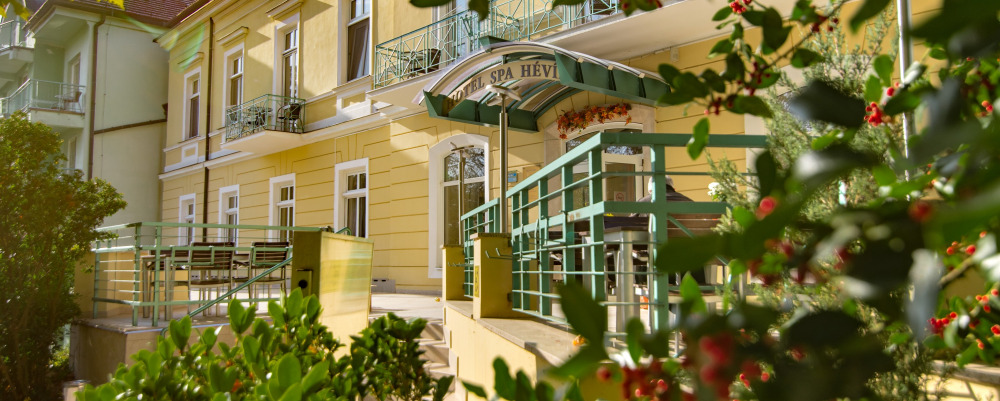
Hotel Spa Hévíz
Address: 8380 Hévíz, Dr. Schulhoff Vilmos Promenade 1
Phone: +36 83 501 708
TREATMENTS REQUIRING A SPECIALIST MEDICAL EXAMINATION
Medical wellness services:
-
Health Assessment – 15,700 HUF
(Includes 1 follow-up consultation)
Our rheumatologist will create a personalized therapy plan based on the examination results. -
Follow-up consultation, prescription writing and injection administration – 7,800 HUF
-
Pool Bath – 3 hours – 3,300 HUF
(includes wellness use: sauna, infrared sauna, jacuzzi) -
Underwater Traction – 20 minutes – 7,800 HUF
Mud Packs
Applied to the body part prescribed by the doctor, with mud at the recommended temperature.
-
More than 6 joints: 20 minutes – 12,800 HUF
-
Up to 6 joints: 20 minutes – 7,800 HUF
Electrotherapy and Other Treatments
-
Electrotherapy – 5,700 HUF
-
Combined Electrotherapy (US + TENS or US + Interference) – 8,600 HUF
-
Four-Cell Galvanic Bath – 5,900 HUF
-
Ultrasound – 6,900 HUF
-
HIVAMAT (Deep Oscillation Therapy) – 8,600 HUF
-
Whirlpool Bath (arm or leg) – 5,100 HUF
-
Packs (sulphur, ritex, PCP, humino – max. 4 joints) – 7,900 HUF
-
Magnet Therapy (blanket or ring) – 6,000 HUF
-
Shockwave Therapy – 9,400 HUF
-
Cryotherapy – 5,900 HUF
-
Individual Therapeutic Exercise – 25 minutes – 9,800 HUF
-
Therapeutic Massage (for patients with treatment sheet):
-
20 minutes – 6,600 HUF
-
40 minutes – 9,800 HUF
-
Medical Wellness Packages
(The packages do not include the health assessment fee – participation requires a prior health assessment.)
-
Shockwave Therapy (Medical) – 5 sessions – 42,300 HUF
-
Cryotherapy – 5 sessions – 26,500 HUF
-
Mud Pack Pass (more than 6 joints) – 5 × 20 minutes – 57,600 HUF
-
Underwater Traction Pass:
-
5 × 20 minutes – 35,100 HUF
-
10 × 20 minutes – 68,600 HUF
-
WELLNESS TREATMENTS WITHOUT MEDICAL EXAMINATION
Movement Therapy Services:
-
Cold Therapy Compression – 7,300 HUF
-
Wave Massage Therapy (1 region) – 8,000 HUF
-
Wave Massage Therapy (2 regions) – 12,000 HUF
-
Inversion Table (with professional consultation) – 20 minutes – 7,500 HUF
Mud Variations:
-
Mud & Herbal Back Treatment – 40 minutes – 9,500 HUF
-
Wellness Mud Wrap – 20 minutes – 11,900 HUF
-
Wellness Mud Pack – 20 minutes – 7,500 HUF
(requires consent form – max. 4 joints) -
Wellness Mud Pack Pass – 5 × 20 minutes – 33,700 HUF
(requires consent form – max. 4 joints)
Massage Treatments
Individual Massage
Our therapists use the most suitable techniques and pressure tailored to your muscle condition to achieve the best results.
Available with therapeutic cream or oil.
-
Partial Body Massage: Back–arms or legs–hips – 20 minutes – 6,600 HUF
-
Full Body Massage: Back–arms–legs–hips – 40 minutes – 10,900 HUF
-
Individual Massage Pass:
-
5 × 20 minutes – 29,700 HUF
-
5 × 40 minutes – 49,000 HUF
-
-
Manager Massage (Deep Tissue Massage) – 20 minutes – 9,400 HUF
-
Condition-Specific Massages: 40 minutes – 11,600 HUF
Special Package Offers
-
Spa Regeneration Package 5 – 52,400 HUF
Includes medical consultation + 5 therapeutic treatments (max. 2 per treatment type) -
Spa Regeneration Package 10 – 89,900 HUF
Includes medical consultation + 10 therapeutic treatments (max. 3 per treatment type) -
Spa Regeneration Package 20 – 156,300 HUF
Includes medical consultation + 20 therapeutic treatments (max. 6 per treatment type) -
Nymphaea 1-Week Recreation Package – 103,200 HUF
Includes medical consultation, 10 therapeutic treatments (max. 3 per type), 10-hour Lake Bath Ticket (+ 2 free hours) -
Nymphaea 2-Week Reactivation Package – 201,400 HUF
Includes medical consultation, 20 therapeutic treatments (max. 6 per type), 20-hour Lake Bath Ticket (+ 4 free hours)
Facial Treatments
-
Aromazen Facial Massage – 30 minutes – 12,200 HUF
-
Rose de Luxe Mandala Facial Massage – 40 minutes – 15,500 HUF
-
Up & Up Lifting Facial Massage – 40 minutes – 13,600 HUF
-
Vitalenne Facial Treatment – 70 minutes – 23,400 HUF
-
Rose de Luxe Mandala Luxury Ritual – 100 minutes – 28,900 HUF
-
Stimulenne Luxury Ritual – 100 minutes – 28,900 HUF
-
Cleanenne Facial Treatment – 100 minutes – 28,900 HUF
-
Sakura Luxury Ritual – 120 minutes – 31,500 HUF
-
Pour Homme Men’s Facial – 60 minutes – 20,300 HUF
Additional Cosmetic Treatments
-
Eyelash Tint (Orena) – 30 minutes – 3,600 HUF
-
Eyebrow Tint (Orena) – 20 minutes – 3,600 HUF
-
Eyebrow Shaping (tweezers) – 15 minutes – 2,900 HUF
-
"Eyelash Glance" (3-in-1 treatment, Orena) – 40 minutes – 9,300 HUF
Waxing
-
Upper Lip – 10 minutes – 2,100 HUF
-
Face – 20 minutes – 2,900 HUF
-
Armpits – 20 minutes – 3,100 HUF
-
Arms – 20 minutes – 4,100 HUF
-
Legs to Knee – 20 minutes – 4,600 HUF
-
Bikini Line – 30 minutes – 5,000 HUF
-
Full Legs – 50 minutes – 8,400 HUF
Foot Care
-
Pedicure – 50 minutes – 6,600 HUF
We reserve the right to change prices and opening hours. Valid from 01 April 2025 until revoked.
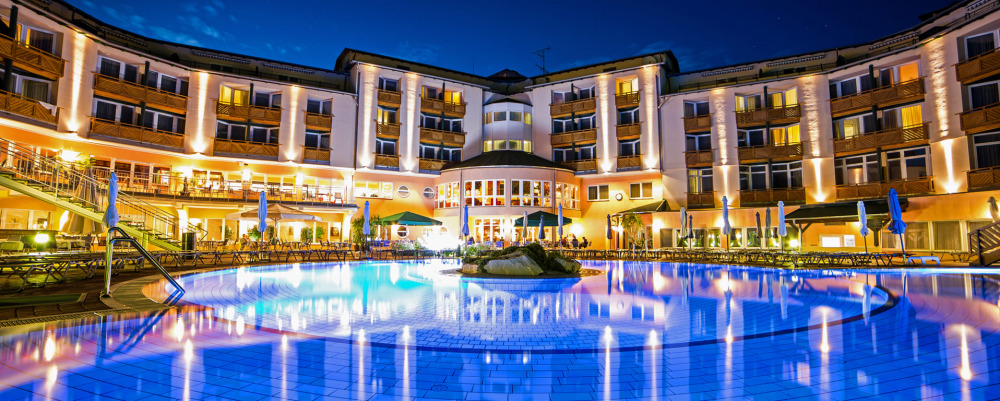
Lotus Therme Hotel & Spa
Address: 8380 Hévíz, Lótuszvirág Street 1
Phone: +36 83 500 500
Please note: Advance booking is required to use the services!
Day Spa Ticket
Price: 15,900 HUF / person
Validity: Monday to Friday and Sundays (subject to availability) between 7:00–22:00
(The day spa ticket is not available on Saturdays)
The Day Spa Ticket includes:
-
Unlimited use of the spa during the validity period of the ticket
-
Bathrobe, towel and sauna sheet
-
Covered parking
Pools
-
Outdoor and indoor pool
-
Jacuzzi
-
Thermal pool
-
Relaxation pool
-
Meditation pool
Sauna World
-
Finnish sauna
-
Steam bath
-
Aroma-light sauna
-
Laconium
-
Garden sauna
-
Infrared sauna
-
Experience showers
-
Kneipp foot bath
-
Sauna ceremonies (17:00 session available subject to capacity, with prior sign-up)
Deposit
4,000 HUF / person (cash only)
The deposit covers the wristband (used for opening the lockers) and the card for bathrobe/towel rental.
The deposit is refundable upon returning the wristband and card at the Spa reception.
Payment Options
-
Tickets: Cash or credit card (HUF)
-
Deposit: Cash only (HUF)
Parking
Parking is free of charge for guests. Please take a ticket at the barrier when entering.
Before leaving, have your ticket validated at the reception — otherwise, you will not be able to exit the car park.
Valid subject to hotel occupancy, except on public holidays and long weekends
Advance Booking Required
Phone: +36 83 500 557
Email: info@lotustherme.net
Culinary Delights at the Lotus Therme Hotel & Spa Corvinus Restaurant!
Price: 19,900 HUF / person
Evening buffet dinner with live music and dancing.
Opening Hours: 17:30 – 21:30
Advance table reservation is required, confirmed according to hotel capacity, except on public holidays and long weekends.
Please note that Lotus Therme does not accept pets.
Advance reservation:
Phone: +36 83 500 560
Email: attila.toreky@lotustherme.net
Additional Services
-
Tennis court rental: 3,000 HUF / court for 2 people
-
The hotel bar is also open to non-resident guests (except during private events, which are rare).
-
Spa and beauty treatments are available for external guests with prior booking.
(Medical consultation is mandatory for medical treatments.)
Further information about wellness treatments:
https://lotustherme.net/en/wellness
https://lotustherme.net/en/health
https://lotustherme.net/en/beauty
Further information about medical treatments:
https://lotustherme.net/en/medical-treatments
https://lotustherme.net/en/traditional-cure-packages
52. Tourinform Office
Last modification: 2023. August. 02. 12:50
The Tourinform Office is the main information service provider for the visitors arriving in Hévíz; you should also pop in if you have any question or you want to make enquiries about any programs and events in the town. The Office is located in the walking street so it is within easy reach both for motorists and pedestrians. You’ll find a wide range of information publications (leaflets, promotional booklets, calendar of events, catalogue of accommodation, etc.) in the Tourinform Office.
Találati relevancia adatok
Tárolt adatok:
53. Picnic Hévíz
Last modification: 2025. May. 27. 15:23
Találati relevancia adatok
Tárolt adatok:
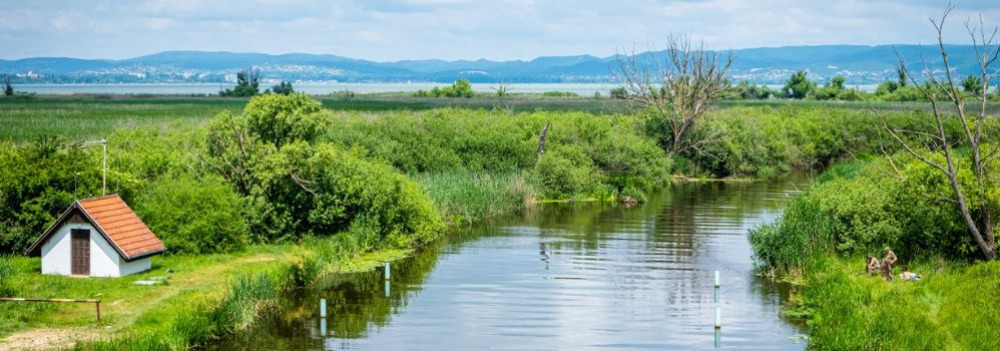
Did you know the Zala River once flowed into the Drava and only later “found” Lake Balaton?
The history of western Hungary’s water systems is not just a fascinating geological puzzle — it reads like an epic of Earth history: riverbeds shift, rivers “consume” one another, and even Lake Balaton doesn’t enter the scene until the final chapter. Discover how nature reshaped this landscape stroke by stroke — and how the Zala became Balaton’s most vital source of water.
The Quaternary Period and the Power of Landscape Formation
What sets the Quaternary Period (2.58 million years ago to the present) apart from earlier geological epochs is that the surface-shaping processes of this time — and the landforms they produced — continue to define our geographic environment today.
Pleistocene Changes: Riverbed Migrations and Terraces
One of the most pivotal surface processes during the Pleistocene (2.58 to 0.01 million years ago) was the migration of riverbeds and the formation of terraces and alluvial fans. These changes were closely tied to the slow retreat of the Pannonian Lake, which once filled much of the Carpathian Basin (see also: The Legacy of the Ancient Pannonian Lake).
The Ancient Danube Moves West
The early Danube initially flowed westward across what is now western Hungary, draining into the retreating Pannonian Lake. This westward course likely remained until the early Pleistocene.
A River’s Great Turning Point
The most dramatic hydrological change in the Carpathian Basin occurred between the Pliocene and Pleistocene: the formation of the Danube’s Visegrád Gorge (today’s Danube Bend), which diverted the river toward the center of the country and what is now the Pest Plain.
This shift profoundly affected all its former western tributaries — including the Zala.
The Story of the Zala: Migration and Capture
The river system of Central Transdanubia evolved in surprising ways, and the Zala’s journey is one of its most remarkable chapters. The Rába River already flowed northeastward toward the Little Hungarian Plain. The ancient Marcal, running northward, flowed into the Rába — and into it, in turn, flowed the ancient Zala.
But nature redrew the map — using the Zala as its brush. A now-vanished river flowing from north to south (its remnants visible today between Zalaszentgrót and Zalavár) cut into the landscape through a process called headward erosion — where rivers erode backward into the terrain, much like a hot knife slicing through butter. Eventually, it cut into the ancient Zala’s valley and “captured” the river, diverting it into its own course.
A New Path — and the Birth of Lake Balaton
From then on, the Zala made a sharp turn south at Türje and — with no Lake Balaton yet in existence — initially emptied into the Drava. Later, as the depression that would one day become Lake Balaton deepened, the Zala was gradually drawn toward it.
Lake Balaton, as a continuous body of water, is only about 5,000 years old — but for millions of years before, the Zala had already been on a winding journey that ultimately made it Balaton’s primary source of water, and the most life-giving river in the region today.

The Life-Giving Winds of the Ice Age: How Loess Shaped the Land
Did you know that Transdanubia’s rich, golden soils are actually a gift from the winds of the Ice Age? Loess isn’t just a dry geological term — it’s an ancient natural recipe that gave rise to some of the most fertile soils in the Carpathian Basin. Where vineyards grow today and birds nest in loess cliffs, strong winds once carried yellow dust across the landscape — for thousands of years. Learn how this unique sediment shaped the land and why loess is still essential for sustainable farming today.
What Is Loess and How Did It Form?
The term loess comes from the German word lose, meaning "loose." Loess is a fine-grained, yellowish sediment that was deposited during the Pleistocene epoch (2.58–0.01 million years ago), particularly during glacial periods. It formed in periglacial environments south of the great Scandinavian ice sheet — cold, dry landscapes with little or no vegetation.
The dust was carried by strong Ice Age winds from floodplains and barren steppes, and slowly accumulated over tens of thousands of years. Eventually, calcium carbonate cemented these layers into loess, which developed characteristic vertical fissures.
It’s important to note that the Pleistocene wasn't a single “Ice Age,” but a period that included alternating cold and warm phases — some even warmer than today.
Loess and the Landscape
Loess gave the Carpathian Basin — especially Transdanubia — its distinct terrain.
Steep loess cliffs (sometimes up to 10 meters high), caves that provide nesting sites for bee-eaters and sand martins, centuries-old sunken roads carved into hillsides, and exposed root systems are all part of the landscape’s geological legacy.
Together, they define the unique character of this region — shaped by time, wind, and stone.
Fertility and Water Retention
Loess-rich areas have produced some of the most fertile soils in the region. Many local producers farm on land that sits atop loess. This creates an excellent foundation for agriculture — not just because of the high humus content, but also because loess has outstanding water-holding capacity. Its vertical pores allow moisture to penetrate deeply and remain in the soil, even during dry periods.
A Modern Echo — Dust from the Sahara
Interestingly, the fine Saharan dust that now reaches Central Europe more frequently can be seen as a modern counterpart to loess-forming material. It’s a reminder that the powerful natural forces that shaped the land long ago are still at work today — just on a different scale.

Imagine a vast body of water — over 1,000 meters deep and more than 400 times the size of Lake Balaton — once rippling across this land. The story of the Pannonian Lake is not just a fascinating chapter of geological history, but a legacy that continues to shape the region: it left behind mineral resources, fertile soils, and even inspired legends. Discover how an ancient lake transformed Transdanubia — and why its impact is still felt today.
An Inland Sea for Millions of Years
At its greatest extent, the Pannonian Lake covered an enormous area, far surpassing the size of today’s Balaton. For millions of years (approximately 12 to 8.5 million years ago), it dominated the region. As surrounding mountain ranges gradually rose, the lake became cut off from the world’s oceans. Its water slowly turned fresh, and its basin began to fill with sediments. Because of its isolation, the lake developed a unique ecosystem with many endemic species.
The Lake Didn’t Appear Overnight
The Pannonian Lake didn’t simply “appear” in the Carpathian Basin. Its formation was the result of millions of years of tectonic activity and shifting climate. It emerged as an independent, enclosed body of water — no longer connected to the open seas.
Deep Waters, Varied Shores
In some areas, the lake reached depths of over 1,000 meters. Elsewhere, shallower zones supported lagoons, river deltas, and small, isolated lakes. During high water periods, rocky shorelines formed along the mountain fringes — traces of which can still be found today in the Keszthely Hills and the Mecsek Mountains.
The Lake’s Retreat — and Sediment Legacy
Despite its size, the lake was eventually filled in by immense volumes of sediment, carried mainly by rivers flowing from the Alps and the Carpathians. Over the course of 6.5 million years, it gradually disappeared from the landscape.
What did it leave behind?
Its sediments — composed mostly of sand, clay, and fine silt — became the so-called “Pannonian formations,” which today hold key mineral resources (such as petroleum) and aquifers. These formations define much of the surface geology of Transdanubia, including the Zala Hills.
Fertile soils later formed on the laminated silty and clay-rich deposits of the Somló Formation. Even the legendary “Tihany goat’s hoof” fossils — actually worn shell fragments of the Congeria ungulacaprae mollusk — can still be found embedded in these ancient layers.
The Final Lakes and a Gradual Goodbye
Because most of the sediment entered from the northwest, north, and northeast, the lake slowly retreated toward the south and southeast — as if it were “withdrawing” from what is now Hungary.
Small remnant lakes persisted for much longer in areas of present-day Slavonia (Croatia) and northern Serbia, but due to their different scale, character, and fauna, they are not considered true successors of the ancient Pannonian Lake.

About 10,000 years ago, rapid climate warming triggered a cascade of natural responses: torrential floods, landslides, and intense rock weathering. The landscape we walk on today was not shaped over mere centuries, but by the dramatic forces of climate and water, working together. Did you know that the Zala Valley floor is made up of sediments deposited by a kind of "river of time"? Discover how the Earth’s surface became one of the most sensitive indicators of climate change.
Climate Change: Not Just a Modern Phenomenon
We often associate climate change with contemporary issues, but Earth’s climate has shifted many times throughout its history — sometimes quite rapidly. Within large-scale climatic cycles, alternating periods of warming and cooling have long been part of the planet’s natural rhythm.
When Climate Changes, Everything Reacts
A change in climate sets off a chain reaction of environmental processes. It’s not just animals and plants that respond — so does the landscape itself.
Around 10,000 years ago, as the climate warmed significantly, rainfall became more intense.
More rain meant more erosion: stormwater began washing away sediment from hills and valleys into riverbeds. The rivers, now carrying more water and more sediment, flooded more often and spread these materials across the landscape.
Shaping the Terrain
This had a major impact on topography: the land surface became more fragmented and dynamic. Warming temperatures also sped up chemical and physical weathering, breaking down bedrock and helping fertile soil layers to develop.
In short, natural geological processes that had long been underway suddenly accelerated — and reshaped the surface of the land.
Young Sediments at the Base of the Slopes
Today, in many areas of the region, the lower slopes and valley edges are coated with sediment — debris washed down from higher ground, largely within the last 10,000–20,000 years. In the Zala Valley, for instance, these deposits have spread so far that they now reach the center of the valley floor.
The original bedrock source of these sediments varies: in Zala, it’s typically Pannonian sand (Somló Formation), while in the Keszthely Hills, marine-origin carbonates dominate — mostly dolomite, with some limestone. These sediments now appear as fine gravel, pebbles, or coarse sand, quietly recording the environmental changes of the recent past.

Imagine a tropical sea where the dolomitic peaks of the Keszthely Hills now rise. The landscapes we consider timeless are, in fact, fleeting guests on Earth’s ever-changing stage. How does a shallow tropical sea become Hungarian highlands? Why does dolomite crack? And how does this still influence local farming today? Travel back millions of years into a story written in stone.
The Surface: Only Seemingly Permanent
Mountains, plains, islands, seas, rivers, and lakes may appear permanent within a human lifetime — but from Earth’s perspective, they are only temporary scenes. The rocks that form our planet’s surface are constantly in motion. Like the shattered shell of a boiled egg, tectonic plates drift endlessly atop the semi-fluid mantle beneath them.
Some crash together or sink beneath one another to create towering mountain ranges, while others subside, forming deep trenches or basins that may fill with water. That’s how the dolomite and limestone now forming the Keszthely Hills were once deposited — in the shallow waters of an ancient tropical sea, thousands of kilometers from their present location and long since gone.
The scene would have resembled the crystal-clear shallows of today’s Bahamian paradise.
Volcanoes in the North, a Tropical Sea to the South
While the northern block of the Keszthely Hills is made of relatively young (a few million years old) volcanic rock, the southern section — including Rezi and Cserszegtomaj — is dominated by much older dolomite, formed in those ancient tropical seas. Alongside widespread formations of so-called Main Dolomite, small patches of Rezi Dolomite can also be found — dating back over 200 million years.
The Keszthely Plateau is dissected by a north–south valley system and crisscrossed by micro-tectonic fault lines. Due to the shallow topsoil and varied terrain, more than 70% of the area is forested. Its karst surface experiences year-round water scarcity and has unique ecological features.
The plateau is divided by intermontane basins and bordered by deep tectonic fractures (such as the Hévíz and Ederics faults), making the area seismically sensitive.
Geology and Today’s Land Use
Soils formed on the debris of weathered dolomite provide the natural foundation for land use in the region. Several of our local producers cultivate land along the western edge of the Keszthely Plateau, where farming is defined by the proximity of a highland landscape — a plateau formed of horsts rising 350–440 meters, framed by tectonic fault lines.
